Spain is a country with a diverse bird population, boasting more than 600 species of birds, including both resident and migratory birds.
Spain’s geographical location, with its position between Europe and Africa, and its warm Mediterranean climate make it an ideal home for these feathered creatures.
Spain also has diverse landscapes, such as the Pyrenees, the Mediterranean coastal plain, the mountainous regions of Sierra Nevada, and the lush valleys of Ebro and Duero, all of which attract different species of birds.
This rich birdlife and stunning landscape make Spain one of the best places in Europe for bird watching.
In this article, we will delve into the diverse species of birds that call Spain home and explore their habitats, behaviors, as well as their cultural and historical importance.
1. Golden Eagle
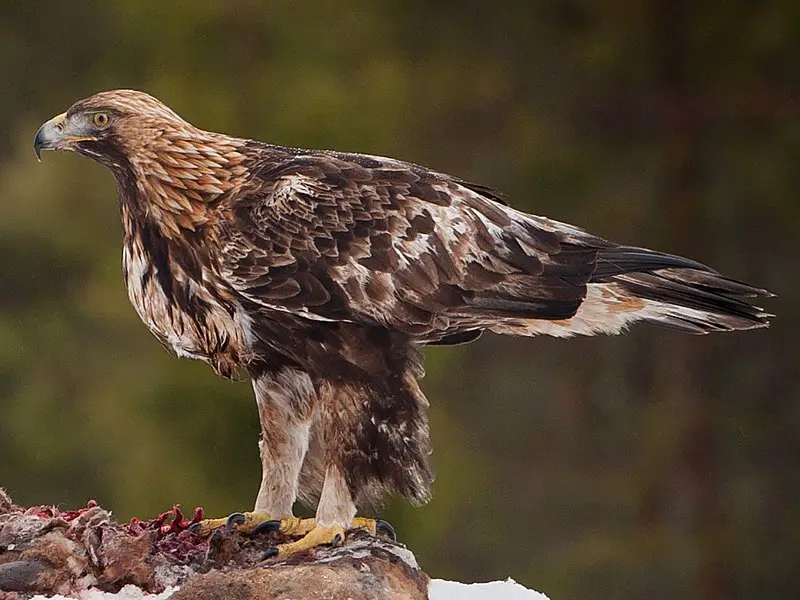
The Golden Eagle is an iconic bird of prey found throughout the northern hemisphere. It is a large, powerful raptor with dark brown feathers and lighter golden-brown plumage on its nape.
Immature eagles have white patches around their beaks, tails and wings which they lose as they mature.
Its diet consists mostly of small mammals such as rabbits, hares and marmots but can also include birds or reptiles depending on where it lives.
These majestic creatures are known for their remarkable strength in flight; using thermal updrafts to soar high into the sky searching for food or simply enjoying the view below them.
They are often seen soaring alone over open expanses looking out for potential threats from other predators like wolves or foxes that may encroach upon their territory.Scientific classification:
| Kingdom | Animalia |
| Phylum | Chordata |
| Class | Aves |
| Order | Accipitriformes |
| Family | Accipitridae |
| Genus | Aquila |
| Species | A. chrysaetos |
Also Featured In: Most Common Birds in China, Birds That Live in Colorado
2. Rock Dove
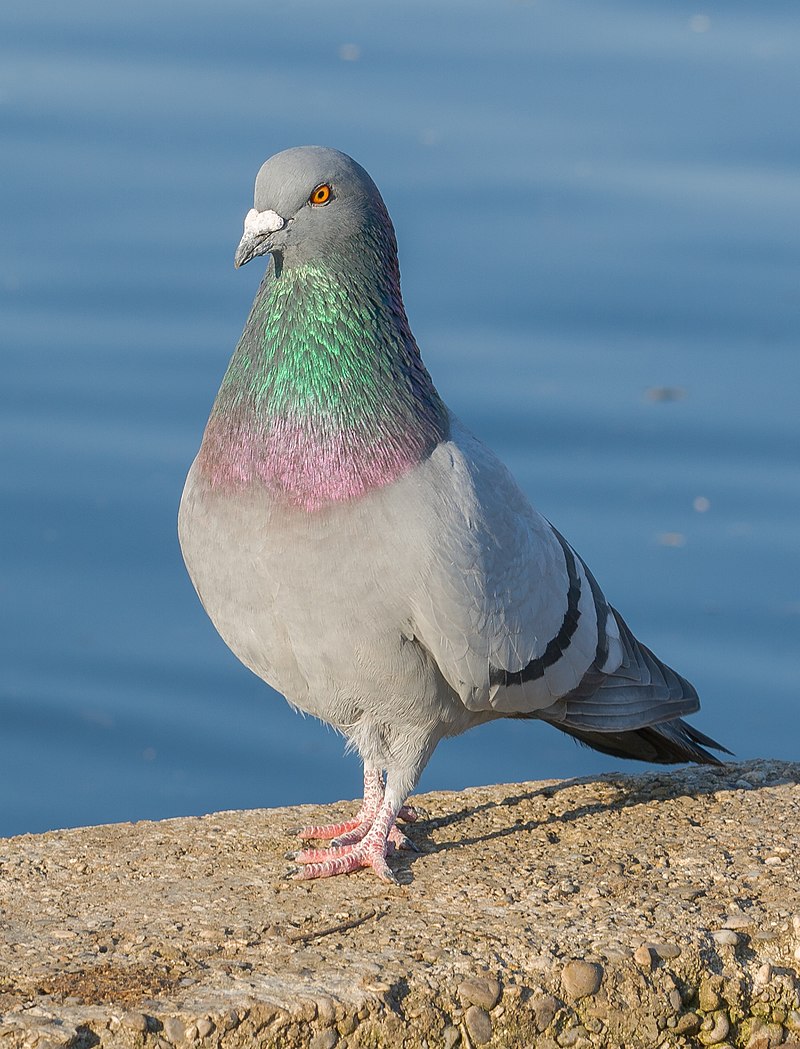
Rock dove, also known as Rock Pigeon or Common Pigeon, is a member of the bird family Columbidae.
It is considered to be an important creature worldwide due to its domestication by humans centuries ago; resulting in the modern-day Domestic pigeon which descends from this species.
Its population has increased over time because some domestic pigeons have escaped captivity and joined wild populations.
The rock dove can most easily be identified by its prominent blue-grey feathers with darker bars on wings and tail along with two black bands on each wing.
They are typically found in large flocks near cliffs or buildings but may also inhabit rural habitats such as open fields and meadows if there’s enough food available for them nearby.
Although they don’t migrate far distances like other birds, their numbers increase significantly during winter months.
When more food sources become available closeby so that they won’t need to travel too far away from home base for nourishment.Scientific classification:
| Kingdom | Animalia |
| Phylum | Chordata |
| Class | Aves |
| Order | Columbiformes |
| Family | Columbidae |
| Genus | Columba |
| Species | C. livia |
Also Featured In: Common Birds in India, Common Birds in the Cities
3. Black Stork
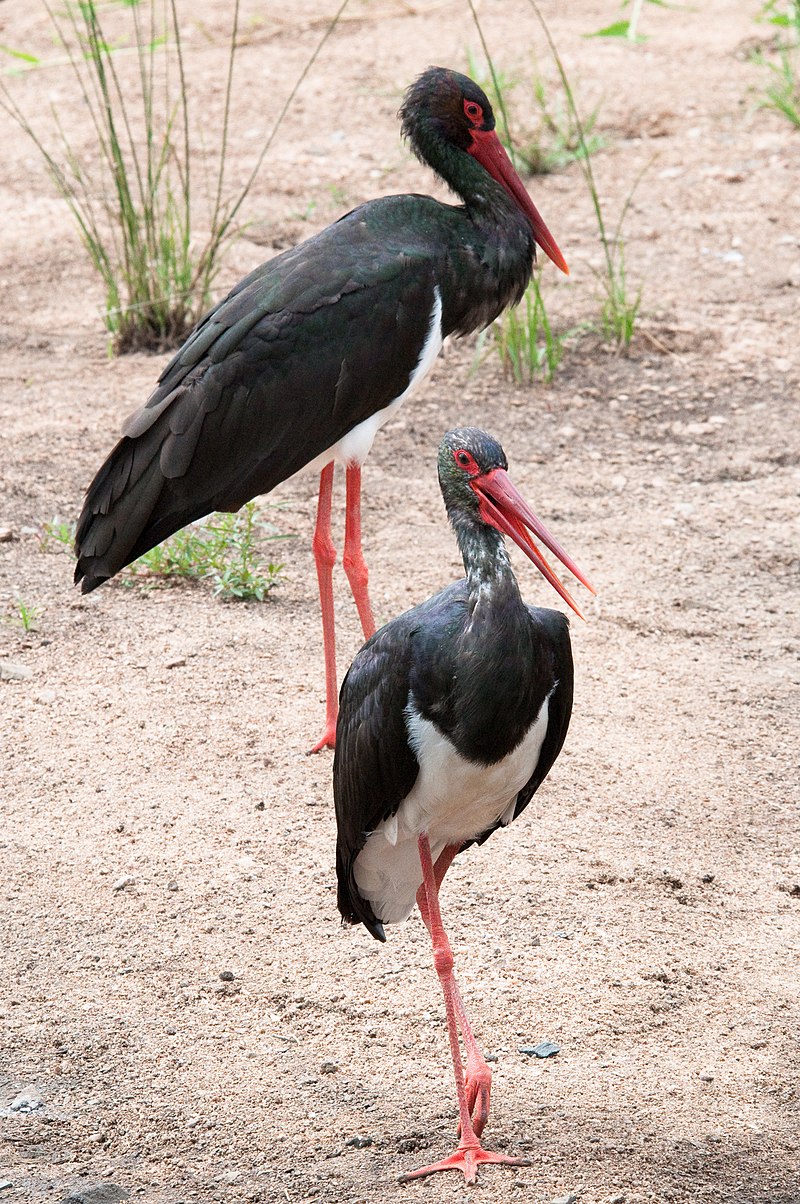
The Black Stork is a majestic bird, with its glossy black feathers and long red legs. Its wingspan ranges from 57 to 61 inches, while it measures an average of 37 to 39 inches tall from beak tip to tail end.
The white underparts contrast perfectly against the dark plumage and are complimented by the vivid red beak.
First described in 1758 by Carl Linnaeus in his “Systema Naturae”, this species has since become popular among bird watchers and naturalists alike for its beauty and gracefulness when flying through the sky.Scientific classification:
| Kingdom | Animalia |
| Phylum | Chordata |
| Class | Aves |
| Order | Ciconiiformes |
| Family | Ciconiidae |
| Genus | Ciconia |
| Species | C. nigra |
Also Featured In: Common Algerian Birds , Bulgarian Birds
4. Black Kite
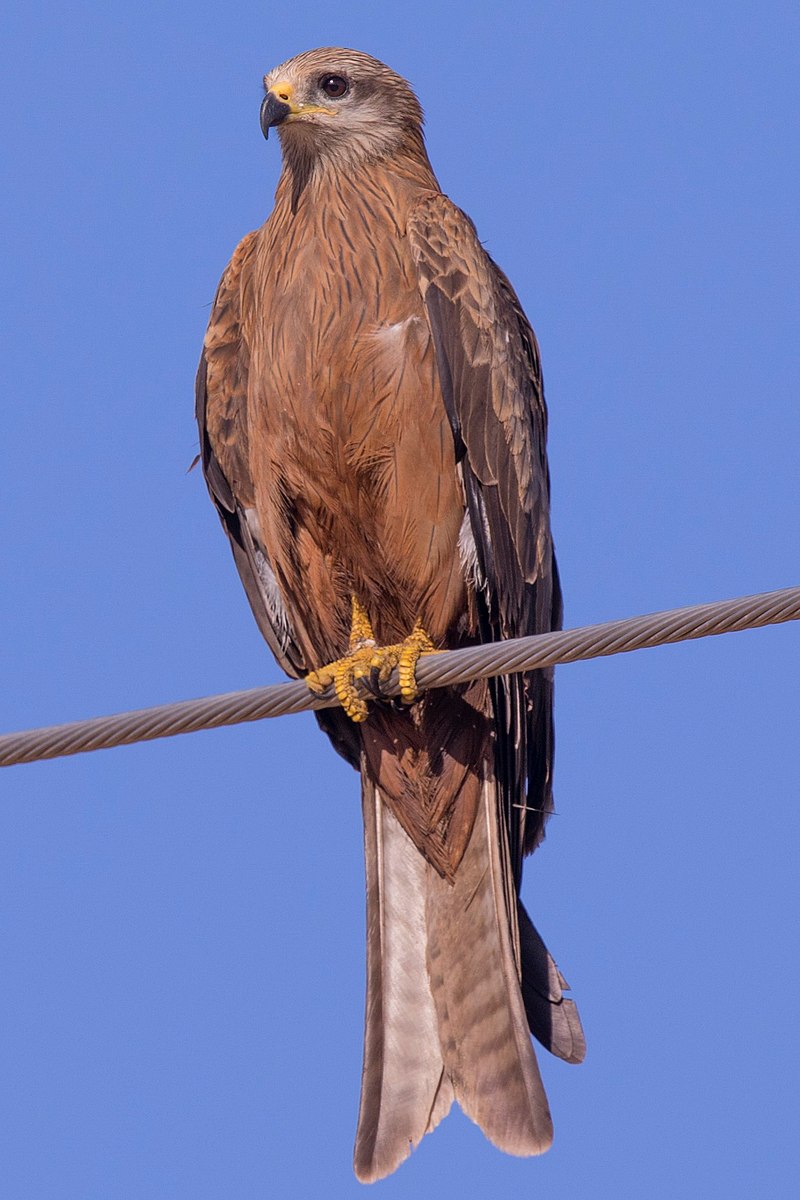
The black kite is one of the most abundant species of diurnal birds of prey in the world, with a global population estimated to be up to 6 million individuals.
It belongs to the family Accipitridae and has medium-sized body size. The wingspan can range from 150 cm – 180cm wide.
They have dark brown feathers on their back and light brown or grey underparts and long forked tails that help it maneuver through.
Its environment while hunting for food like insects, small mammals, reptiles etc., along with scavenging opportunities when available.
Black Kites are found across several continents including Europe, Africa, Asia Minor & Australia where they breed during spring in nests made among trees near wetlands or riversides;
migratory populations move southward away from winter cold temperatures as far east as India & Japan before returning home again next season.Scientific classification:
| Kingdom | Animalia |
| Phylum | Chordata |
| Class | Aves |
| Order | Accipitriformes |
| Family | Accipitridae |
| Genus | Milvus |
| Species | M. migrans |
Also Featured In: Summer Birds that Live around Us, Hong Kong Birds You Need to See
5. House Sparrow
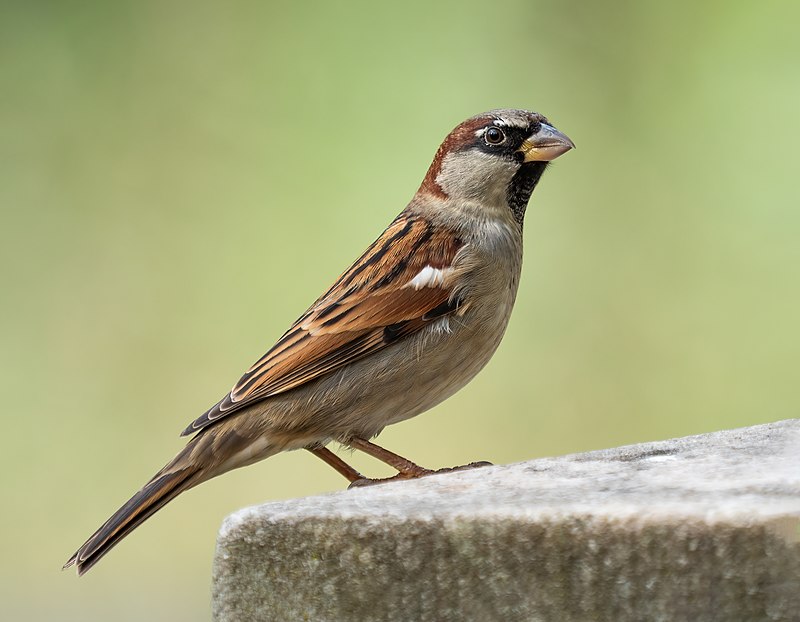
The house sparrow is a small bird of the Passeridae family. It has an average length of 16 cm and weighs 24-39.5 gm.
Females have dull brown and grey plumage, whereas males are brighter, with black, white and brown markings on their wings and back feathers.
This species is one among 25 different kinds in its genus Passer .These birds are found all around the world mainly near human dwellings where they feed off food scraps from garbage bins or gardens etc..
They also make nests close to houses which makes them even more visible to people living nearby.
House sparrows can be seen hopping around yards looking for food during daytime hours but usually hide in colonies at night time.Scientific classification:
| Kingdom | Animalia |
| Phylum | Chordata |
| Class | Aves |
| Order | Passeriformes |
| Family | Passeridae |
| Genus | Passer |
| Species | P. domesticus |
Also Featured In: Most Common United States Birds, Birds for Your Home Garden
6. Shorebirds
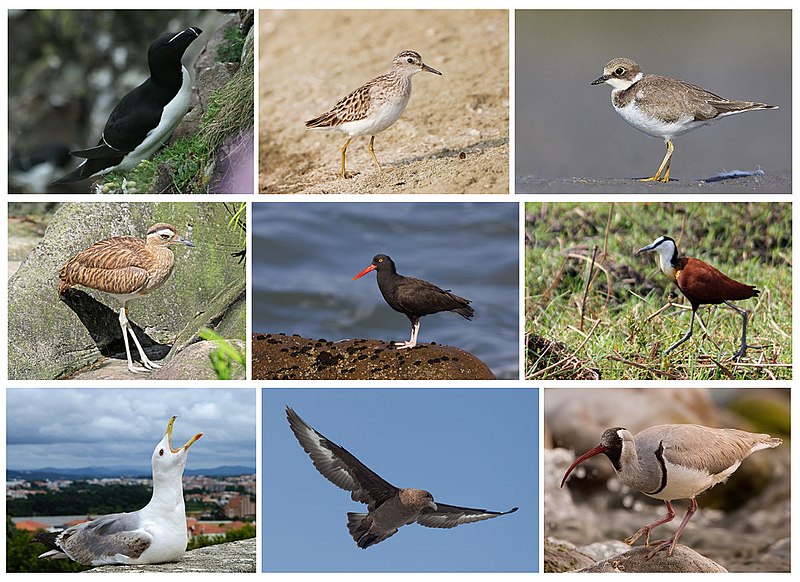
Shorebirds, a diverse group of birds in the Charadriiformes order, are found near water on every continent except Antarctica.
These small to medium-sized birds feed mainly on invertebrates and other small animals but can also be pelagic seabirds or inhabit deserts.
Shorebirds use their long bills to probe mudflats for food like worms and mollusks while some species plunge into the ocean’s depths in search of crustaceans such as crabs and shrimp.
They have strong legs equipped with webbed feet which allow them to move quickly when searching for prey across wetlands, sandbars, beaches and swamps.
Their feathers make them well adapted to life by land or sea due to its hydrophobic nature which helps reduce drag during swimming or flying through windy conditions making it easier for shorebirds survive tough environments around the world.Scientific classification:
| Kingdom | Animalia |
| Phylum | Chordata |
| Class | Aves |
| Infraclass | Neognathae |
| Clade | Neoaves |
| Clade | Gruimorphae |
| Order | Charadriiformes Huxley, 1867 |
Also Featured In: Beautiful Brazilian Birds, Water Birds Live around Us
7. Eurasian Collared Dove
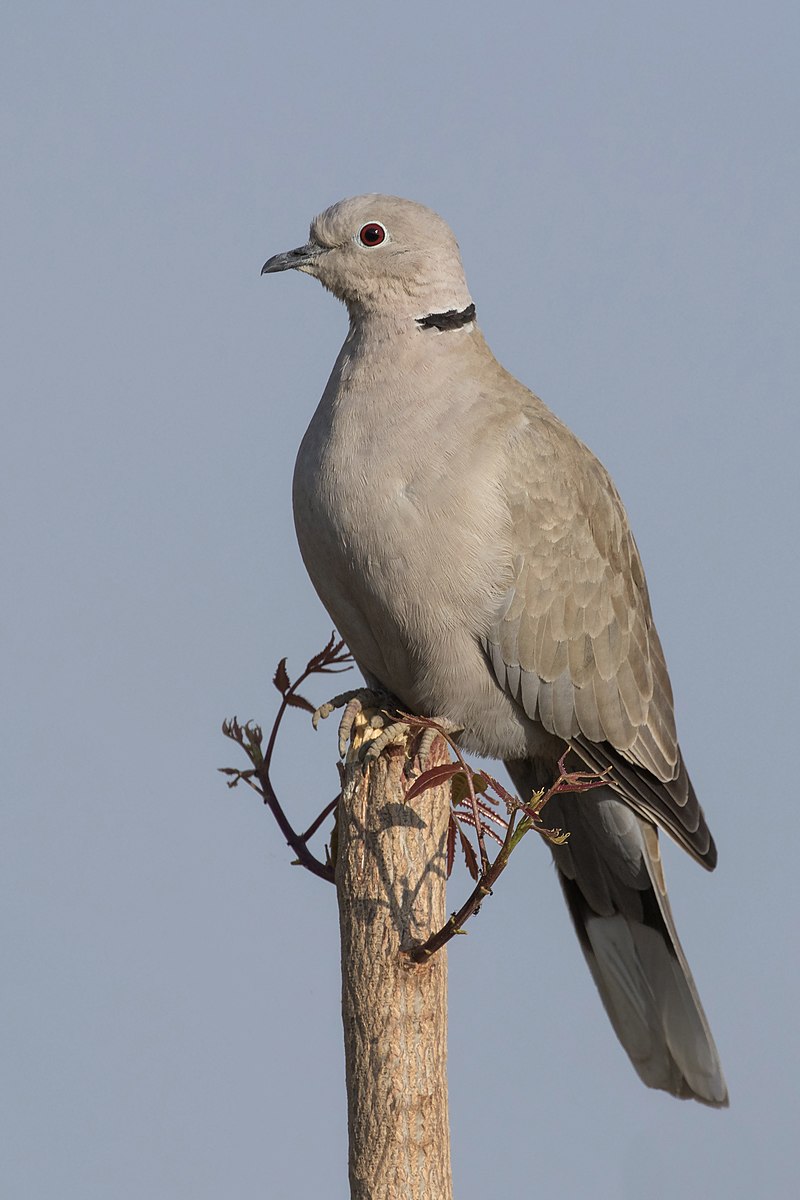
The Eurasian collared dove is a species of bird native to Europe and Asia, with its range expanding through introduction in Japan, North America, and islands in the Caribbean.
It has become so widespread that it is listed as Least Concern on the IUCN Red List. The scientific name for this bird was proposed by Hungarian naturalist Imre Frivaldsz – Columba decaocto.
This beautiful creature typically measures between 33-37 cm from tip to tail feathers, displaying an overall greyish brown plumage; they also have distinctive black half collar around their neck which gives them their common name.
These birds are mainly found inhabiting open woodlands or agricultural lands near human settlements where there’s plenty of food available such as grain fields or gardens where fruits can be eaten off trees.
With a vast global population trend increasing steadily each year these birds make great additions to many backyards throughout the world.Scientific classification:
| Kingdom | Animalia |
| Phylum | Chordata |
| Class | Aves |
| Order | Columbiformes |
| Family | Columbidae |
| Genus | Streptopelia |
| Species | S. decaocto |
Also Featured In: Top Birds Found in Mexico, Most Common Romanian Birds
8. Crow Family
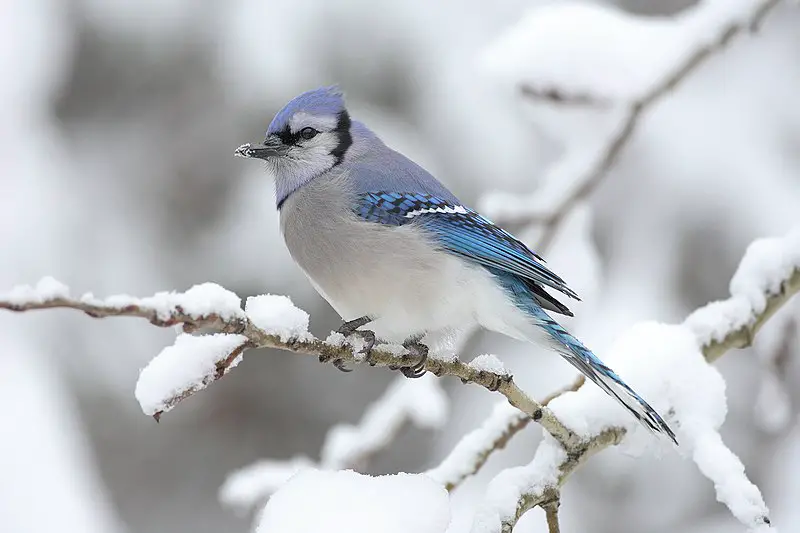
The Crow family is a cosmopolitan group of birds that contains crows, ravens, rooks, jackdaws, jays, magpies and more.
Altogether there are 133 members in this bird family which all share similar characteristics such as large beaks and feet.
The genus Corvus alone makes up over a third of the entire crow family population with species like the common crow or blackbird being some of its most recognizable members.
All these birds have strong social bonds so they often travel in groups to find food sources or build nests together for protection against predators.
With their intelligence and adaptation skills they are able to survive almost anywhere on Earth from mountains to cities making them one of the world’s most successful families of avian creaturesScientific classification:
| Kingdom | Animalia |
| Phylum | Chordata |
| Class | Aves |
| Order | Passeriformes |
| Superfamily | Corvoidea |
| Family | Corvidae Leach, 1820 |
Also Featured In: Common Birds in Japan, Most Common Winter Birds
9. Egyptian Vulture
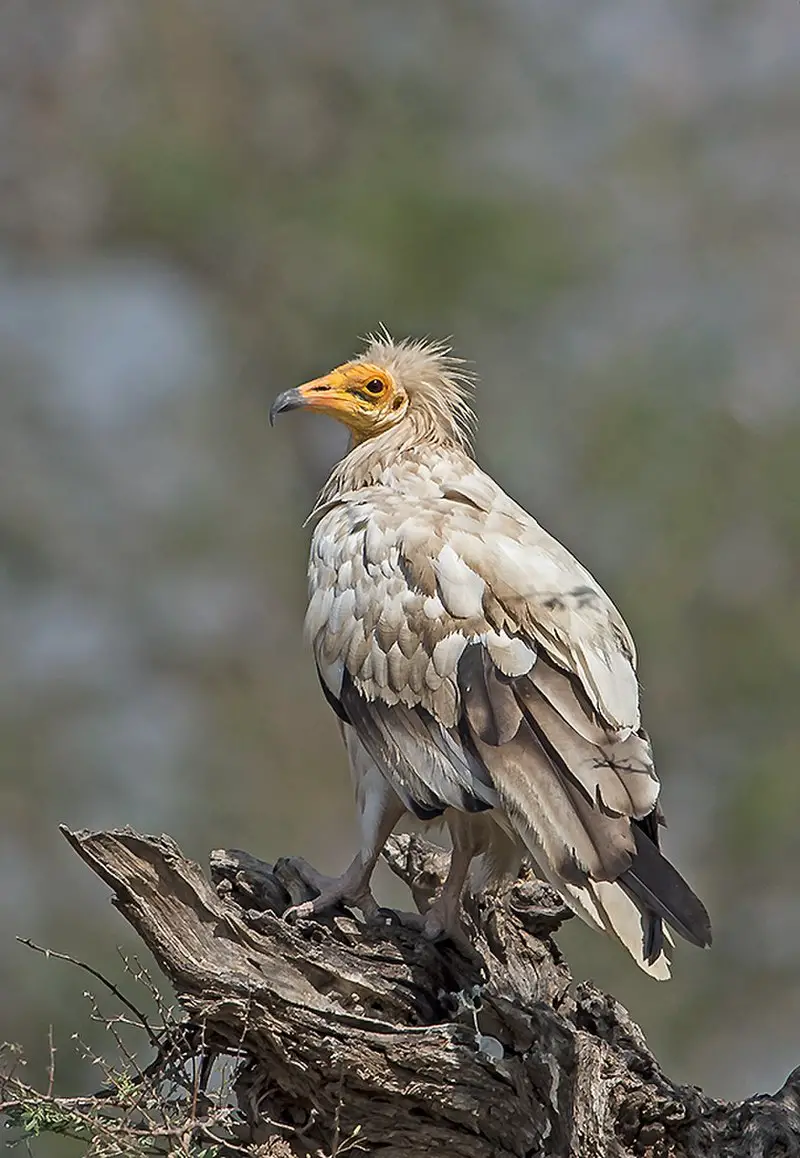
The Egyptian Vulture is a small Old World vulture known for its distinctive wedge-shaped tail and contrasting underwing pattern.
It has been found from the Iberian Peninsula through North Africa to India, making it one of the most widespread birds in that area.
This species eats mostly carrion but will also feed on eggs and small prey if they can find them. Its diet consists mainly of lizards, insects and other invertebrates as well as fruit like figs, grapes or mulberries when available.
The Egyptian Vulture plays an important role in ecosystems by helping to clean up carcasses which could otherwise spread disease or attract predators such as jackals into human settlements.
They are considered vulnerable due to threats including habitat destruction, electrocution from power lines and accidental poisoning – all factors contributing towards their decline in numbers across their rangeScientific classification:
| Kingdom | Animalia |
| Phylum | Chordata |
| Class | Aves |
| Order | Accipitriformes |
| Family | Accipitridae |
| Genus | Neophron Savigny, 1809 |
| Species | N. percnopterus |
Also Featured In: Egyptian Birds, Birds You’ll Find in Albania
10. Cattle Egret
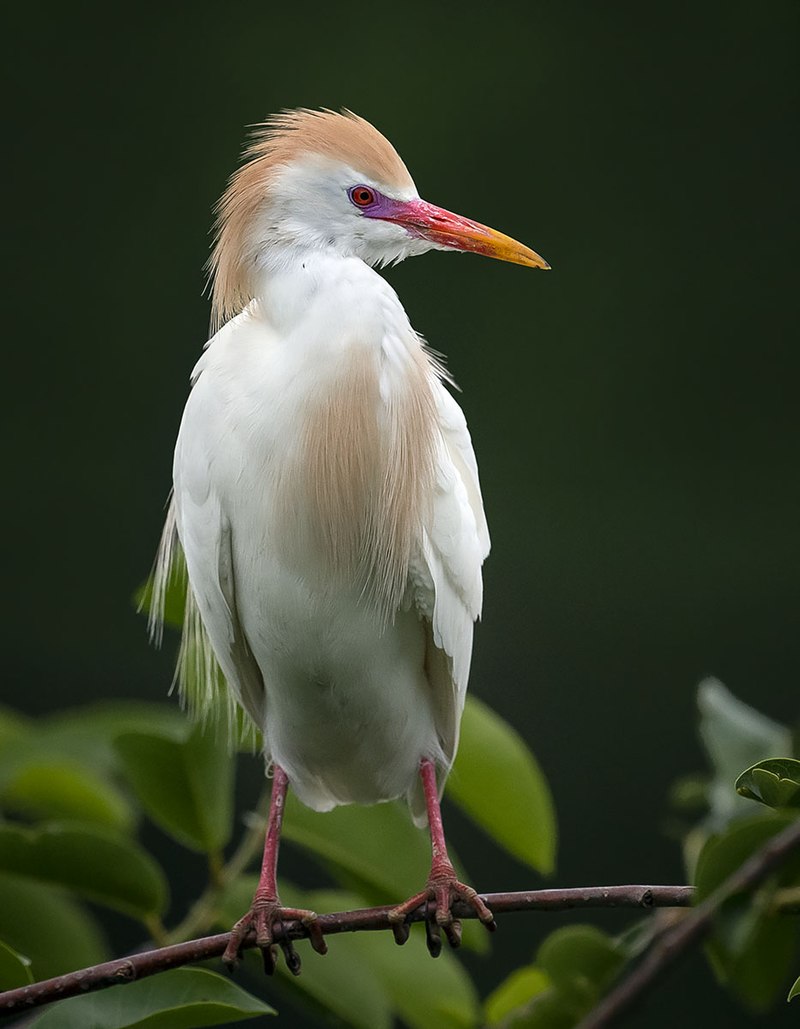
The Cattle Egret is a heron of the family Ardeidae found around the world in tropical, subtropical and warm temperate areas. It has two subspecies: western cattle egret and eastern cattle egret.
They have white plumage with buff plumes on their head, neck and back. The beak is yellowish-orange with black tip while legs are orange or yellow coloured depending on species variation.
This bird usually feeds near large herds of animals such as cows, horses etc., where it finds plenty of insects to eat like grasshoppers, crickets etc..
Its presence benefits these animals by removing ectoparasites from them which leads to healthier livestock population.
It nests colonially in trees or shrubs located close to water bodies during breeding season which generally takes place between March-June every year.Scientific classification:
| Kingdom | Animalia |
| Phylum | Chordata |
| Class | Aves |
| Order | Pelecaniformes |
| Family | Ardeidae |
| Genus | Bubulcus Bonaparte, 1855 |
| Species | B. ibis |
Also Featured In: Asian Birds, Large African Birds You Need to Know
11. European Roller
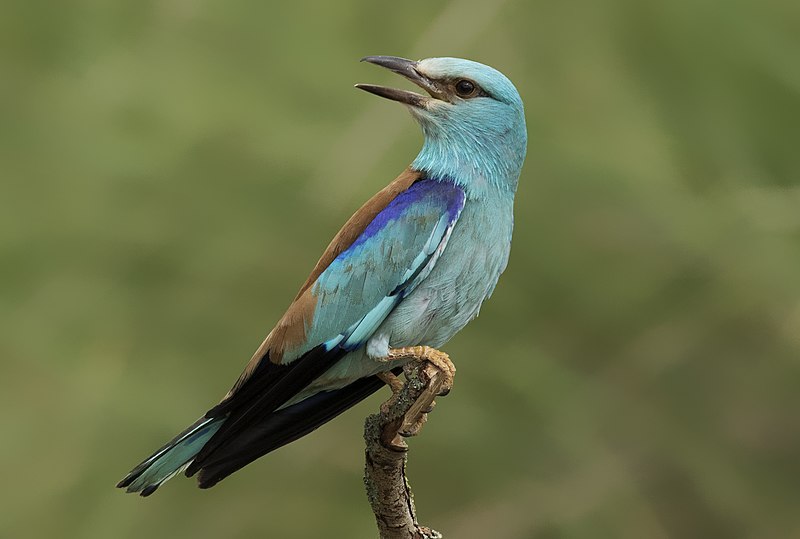
The European roller is a beautiful bird belonging to the Coracias family, and it’s the only one of its kind found in Europe.
It inhabits various habitats such as dry wooded savanna, bushy plains and other areas except for treeless ones.
During wintertime they usually nest in tree holes, while their range extends into Middle East, Central Asia and Maghreb regions.
They have vibrant blue feathers with black stripes along the neck area which makes them stand out from other birds easily.
Its diet consists mainly of insects like grasshoppers or beetles that are hunted by catching them mid-air during flight; this feature adds an extra charm to these magnificent creatures.Scientific classification:
| Kingdom | Animalia |
| Phylum | Chordata |
| Class | Aves |
| Order | Coraciiformes |
| Family | Coraciidae |
| Genus | Coracias |
| Species | C. garrulus |
Also Featured In: Common Uzbekistan Birds, Native Birds of Kazakhstan
12. European Green Woodpecker
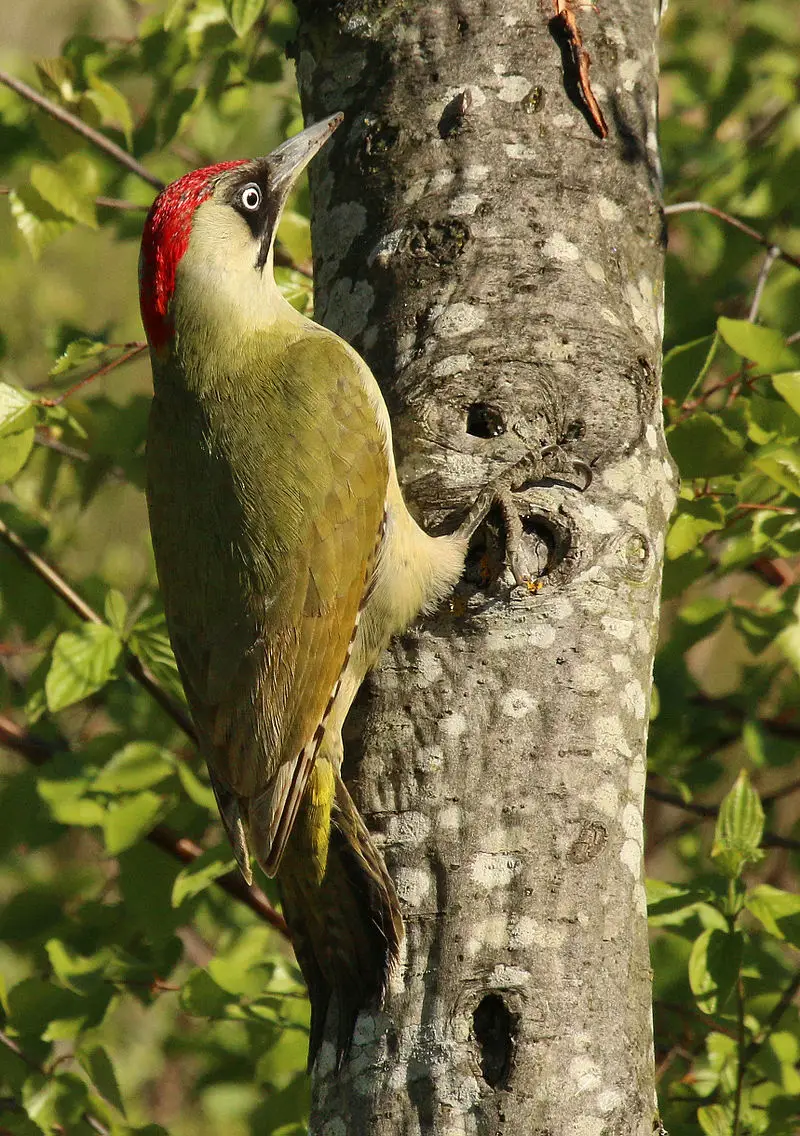
The European green woodpecker is a vibrant species with striking features. The body has an emerald hue, while males have a red crown and black moustache that extends to the middle of their forehead.
Females lack this characteristic feature but instead possess barred markings beneath the wings as well as yellow throats and cheeks.
It can be found in many parts of Europe and western Palearctic regions such as Spain and Portugal where it is replaced by its similar cousin; Iberian green woodpecker (Picus sharpei).
This bird loves inhabiting open forests or grasslands for its food source which typically consists on insects like ants, beetles, spiders among others.
Its powerful bill allows it to dig into tree bark searching for larvae underneath making it an efficient predator in these environments.Scientific classification:
| Kingdom | Animalia |
| Phylum | Chordata |
| Class | Aves |
| Order | Piciformes |
| Family | Picidae |
| Genus | Picus |
| Species | P. viridis |
Also Featured In: Native Birds Of Germany, European Birds
13. White Stork
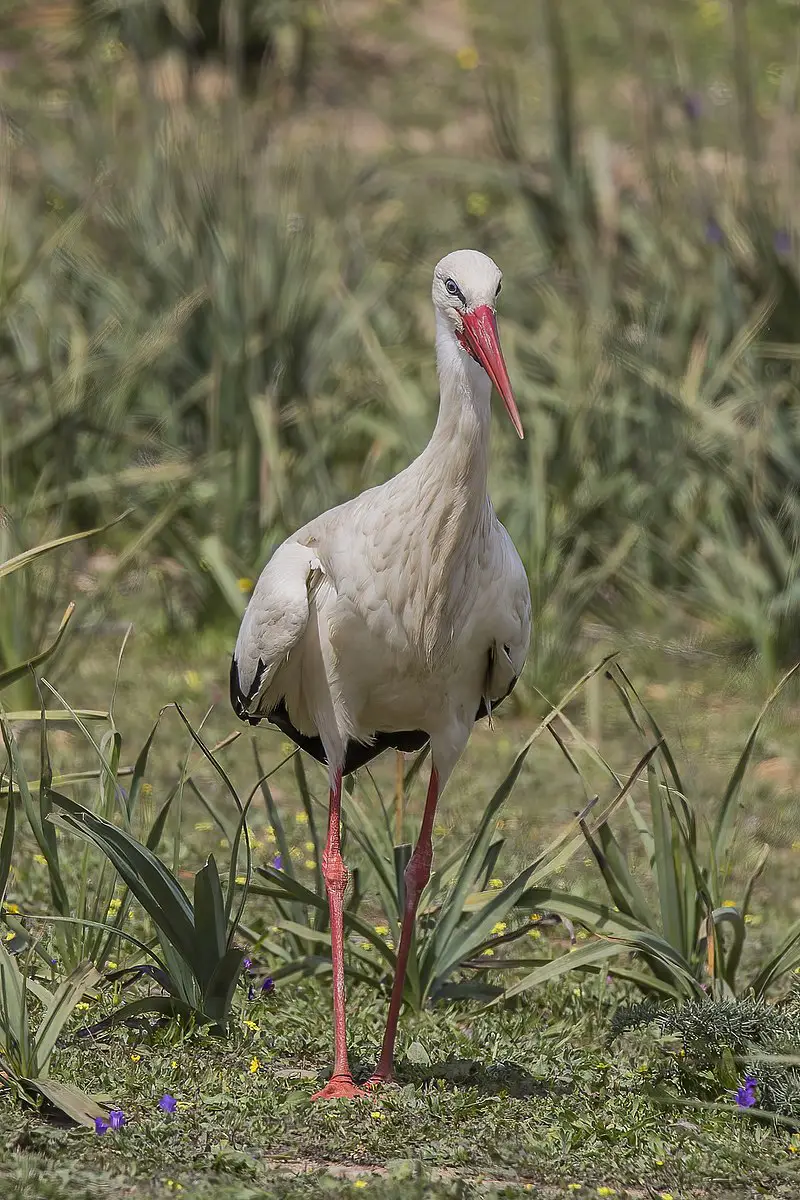
The White Stork is a majestic bird found in Europe, with white plumage and black wings. It has long slender legs and beaks that are usually bright red in color.
The average adult stands around 100 – 115 cm tall from beak to tail tip, while its wing span can reach up to 155-215 cm wide. There are two subspecies of the White Stork which differ slightly by size.
They feed on small animals such as frogs, fish or insects and nest near human dwellings due to the abundance of food available there; they also build nests atop chimneys or roofs when given the chance.
These birds have been revered for centuries as symbols of fertility because their return each spring often coincides with an increase in births among humans living nearby – something superstitious people take great note of.Scientific classification:
| Kingdom | Animalia |
| Phylum | Chordata |
| Class | Aves |
| Order | Ciconiiformes |
| Family | Ciconiidae |
| Genus | Ciconia |
| Species | C. ciconia |
Also Featured In: Belarus Birds You Should Know, Most Common Lithuanian Birds
14. Common Swift
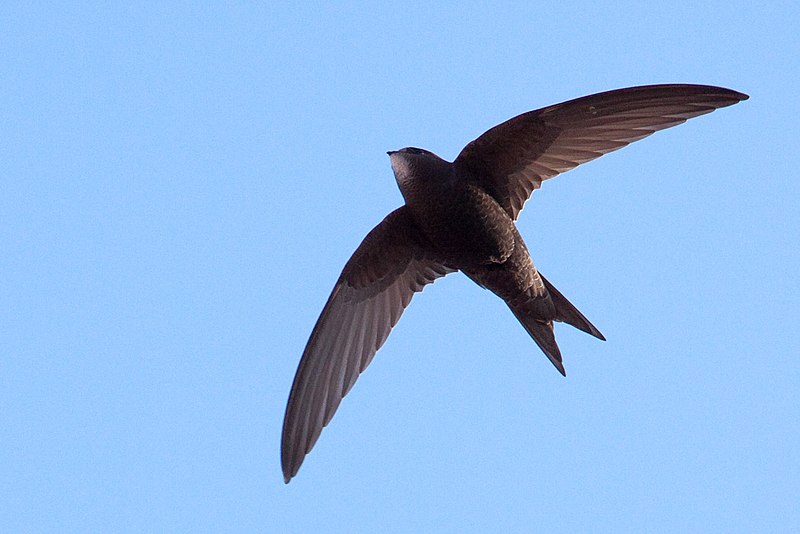
The Common swift is a medium-sized bird with an appearance similar to the barn swallow or house martin.
Its wings are larger, however it is not related to these species but instead belongs in its own order of Apodiformes.
The similarities between the two groups have come about due to convergent evolution and a shared environment.
As for relatives, they can be found among New World hummingbirds and South American swifts; whereas more distant cousins include nightjars as well as treeswifts from Asia/Africa and Australian swiftspecies.
These birds live up high in the air where they remain on constant flight even when sleeping or eating.
They usually migrate south during winter months then return again each springtime bringing life back into our skies.Scientific classification:
| Kingdom | Animalia |
| Phylum | Chordata |
| Class | Aves |
| Order | Apodiformes |
| Family | Apodidae |
| Genus | Apus |
| Species | A. apus |
Also Featured In: Birds of Latvia, Birds that Live in Montenegro
15. Eurasian Hoopoe
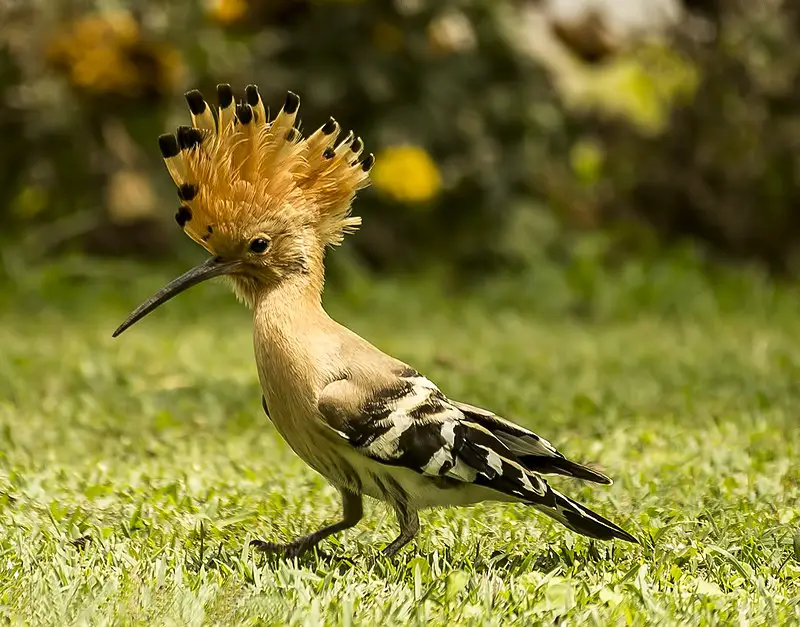
The Eurasian hoopoe is a unique and stunning bird. Its cinnamon-coloured body contrasts sharply with its black-and-white wings, while the tall erectile crest gives it an even more distinctive appearance.
It also has a broad white band across its black tail and a long narrow downcurved beak. When you hear this species of birds call, it’s typically “oop-oop-oop”, very soft yet unmistakable in tone.
This beautiful creature can be found throughout Europe, Asia and northern Africa where they mainly migrate for cooler climates during winter months.
The Eurasian hoopoe is truly one of nature’s most majestic creations – from their vibrant plumage to their mellow calls – making them unforgettable creatures that will never cease to amaze us all.Scientific classification:
| Kingdom | Animalia |
| Phylum | Chordata |
| Class | Aves |
| Order | Bucerotiformes |
| Family | Upupidae |
| Genus | Upupa |
| Species | U. epops |
Also Featured In: Most Common Nature Birds, Ko Mak Birds You Didn’t Know
16. European Goldfinch
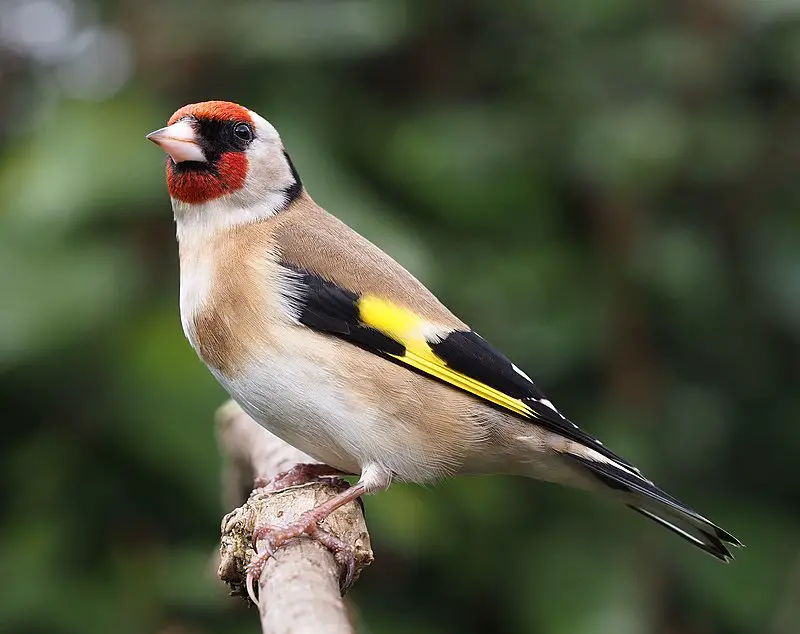
The European Goldfinch is a small passerine bird belonging to the finch family. It inhabits Europe, North Africa, western and central Asia but has been introduced in other places such as Australia, New Zealand and Uruguay.
The breeding male of this species can be easily identified by its red face with black markings around the eyes and black-and-white head.
Its back and flanks are buff or yellowish in color while it has white underparts which contrast well with its dark wings edged in white feathers.
This bird feeds on grains from plants like millet or sunflower seeds along with insects occasionally when available during summer months for food source.
In winter they flock together near sources of water where they find their food among weeds growing there at that time of year.Scientific classification:
| Kingdom | Animalia |
| Phylum | Chordata |
| Class | Aves |
| Order | Passeriformes |
| Family | Fringillidae |
| Subfamily | Carduelinae |
| Genus | Carduelis |
| Species | C. carduelis |
Also Featured In: Most Common Scotland Birds, Autumn Birds You Should Know
17. Red Kite
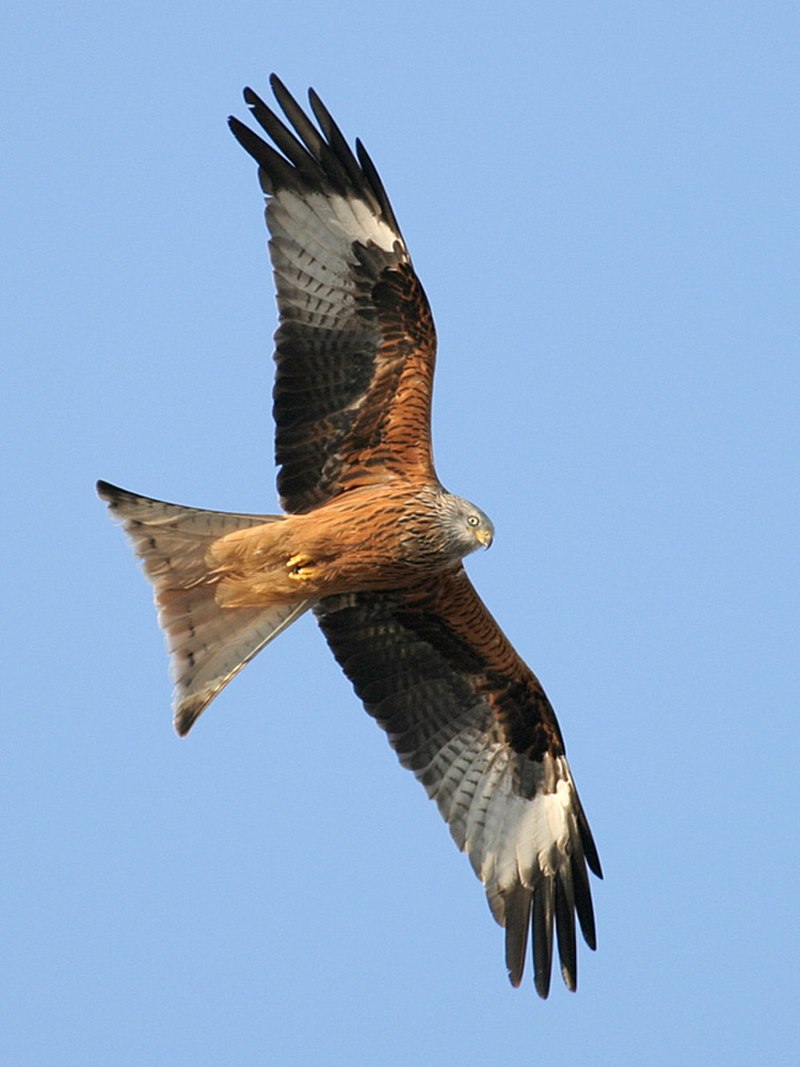
The Red Kite is a magnificent bird of prey, belonging to the family Accipitridae. It can be found in western Europe and northwest Africa where it breeds, while also occurring occasionally in northern Iran.
These birds are medium-large size with wingspans ranging from 125 – 170 cm wide. They have reddish brown plumage on their upperparts and pale gray underneath.
The Red Kite feeds mainly on small mammals, carrion and insects which they hunt for by soaring through the air using thermals to gain altitude before diving down onto its prey.
Furthermore, this species has adapted well to human presence since it often scavenges near roadsides or rubbish dumps as an easy source of food.
All things considered, these majestic creatures make up a beautiful part of our natural environment that should definitely not go unnoticed.Scientific classification:
| Kingdom | Animalia |
| Phylum | Chordata |
| Class | Aves |
| Order | Accipitriformes |
| Family | Accipitridae |
| Genus | Milvus |
| Species | M. milvus |
Also Featured In: Common Slovakian Birds, Scavengers Birds You Should Know
18. Common Blackbird
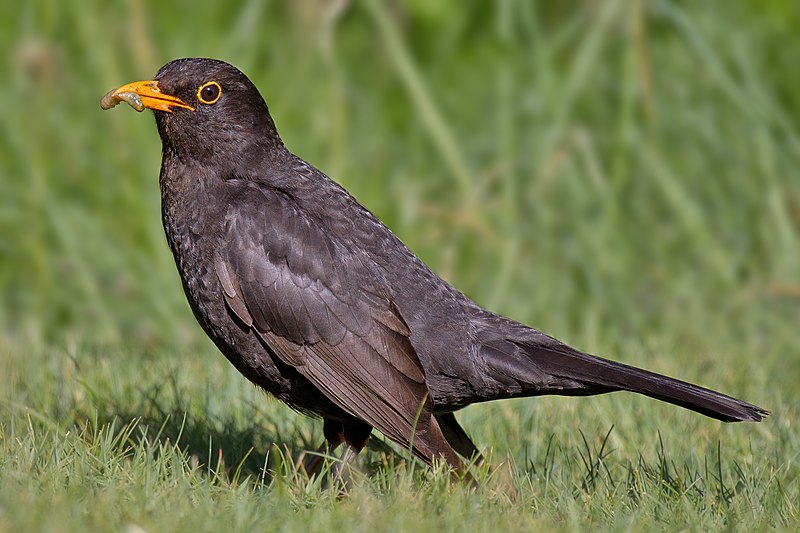
The Common Blackbird is a species of true thrush with the scientific name Turdus merula. Found in Europe, Asiatic Russia and North Africa it has also been introduced to Australia and New Zealand.
The male bird has glossy black plumage while the female’s coloration is more brownish gray.
It is known for its melodious song that can be heard throughout much of the year; typically they are seen alone or in pairs but occasionally form large flocks when food sources become available or during migration periods.
Its diet consists mainly of insects, worms, berries and other fruits as well as some human-provided foods such as bread crumbs or garbage scraps when available.
With its wide distribution range along with ease of adaptation to different habitats this species will likely remain one our most common birds around us.Scientific classification:
| Kingdom | Animalia |
| Phylum | Chordata |
| Class | Aves |
| Order | Passeriformes |
| Family | Turdidae |
| Genus | Turdus |
| Species | T. merula |
Also Featured In: Birds of United Kingdom, Flocks Birds around Us
19. Common Wood Pigeon
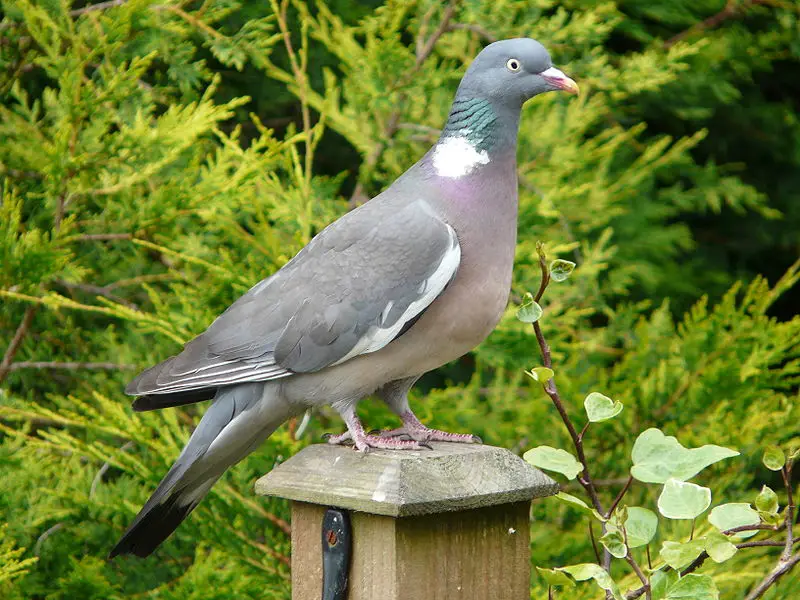
The Common Wood Pigeon is a large bird of the dove and pigeon family, native to the western Palearctic. It has grey plumage with white patches on its wings and neck.
Its head often appears darker than its body due to iridescence in some parts of its feathers. The male woodpigeons have pinkish breasts while females are more brownish-grey coloured.
These birds feed mainly on seeds, fruits, flowers and leaves but will also eat insects when available.
They breed during springtime producing 1-2 clutches per breeding season with two eggs each time which hatch after about 18 days incubation period by both parents taking turns for duty.
They make their nests from twigs collected from nearby trees or places close by and usually raise only one brood at a time making them an important part of nature’s balance as they help keep insect populations under control through their diet choices.Scientific classification:
| Kingdom | Animalia |
| Phylum | Chordata |
| Class | Aves |
| Order | Columbiformes |
| Family | Columbidae |
| Genus | Columba |
| Species | C. palumbus |
Also Featured In: Birds of Sweden, Common Serbian Birds
20. Common Chaffinch

The Common Chaffinch is a beautifully coloured small passerine bird belonging to the finch family.
The males have striking blue-grey caps and rust-red underparts, while the females are more subtle in their colouring but both possess two distinct white wing bars and white sides on their tails.
This gorgeous bird has an incredibly strong voice which can be heard for miles as it sings from exposed perches during mating season.
It lives mainly throughout Europe but also in parts of North Africa and Asia too, favouring woodland areas with plenty of shrubs or trees nearby where they find shelter amongst foliage when needed.
They feed predominantly on seeds from weeds or grains found within grasslands making them particularly useful birds for farmers who rely heavily upon pest control that these little ones provide.Scientific classification:
| Kingdom | Animalia |
| Phylum | Chordata |
| Class | Aves |
| Order | Passeriformes |
| Family | Fringillidae |
| Subfamily | Fringillinae |
| Genus | Fringilla |
| Species | F. coelebs |
Also Featured In: Birds that Calls in the Morning, Common Birds of Portugal
21. Tit
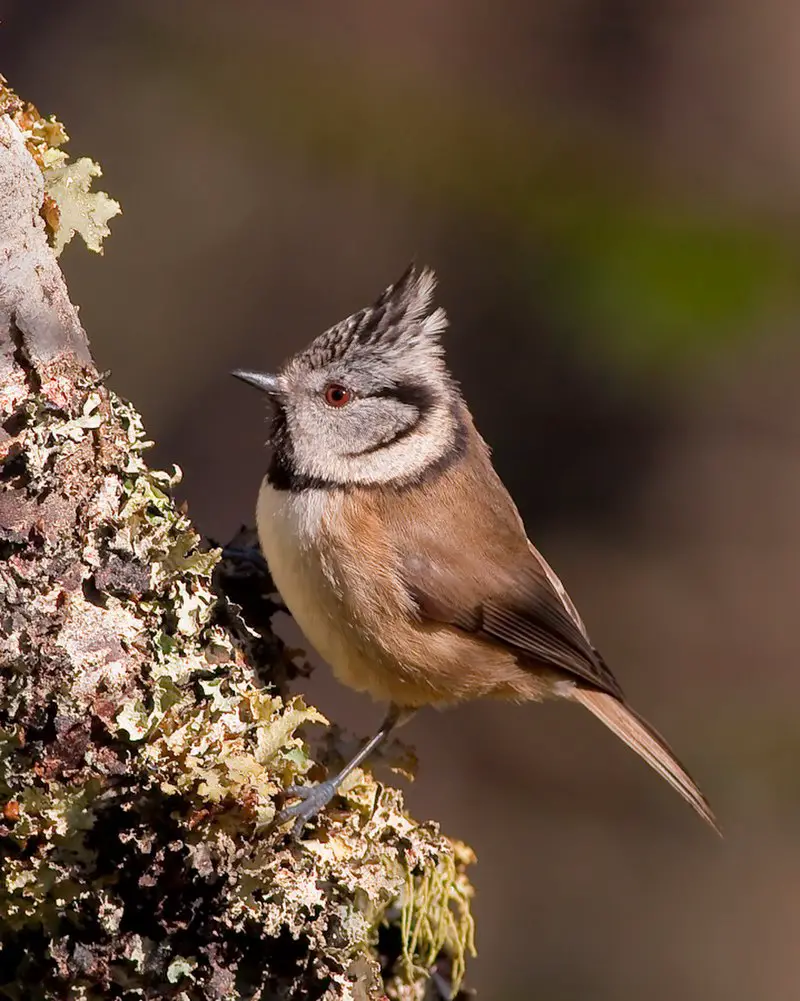
Tit birds are small passerine birds belonging to the family Paridae, found mainly in Northern Hemisphere and Africa.
These active little birds can be seen singing sweet songs throughout the day or scavenging for food at feeders.
They have short, stout bills which they use to crack open seeds and nuts with ease. Tit species range from chickadees to titmice; all of them sport a distinctive black head cap that stands out against their pale grey bodies.
Their bright eyes allow them excellent vision while searching for food – even on gloomy days when other predators may not see as well.
Tits are an important part of any healthy ecosystem and provide many ecological services such as insect control and seed dispersal.Scientific classification:
| Kingdom | Animalia |
| Phylum | Chordata |
| Class | Aves |
| Order | Passeriformes |
| Infraorder | Passerida |
| Family | Paridae Vigors, 1825 |
Also Featured In: Willows Birds Around You, Common Denmark Birds
22. Balearic Shearwater
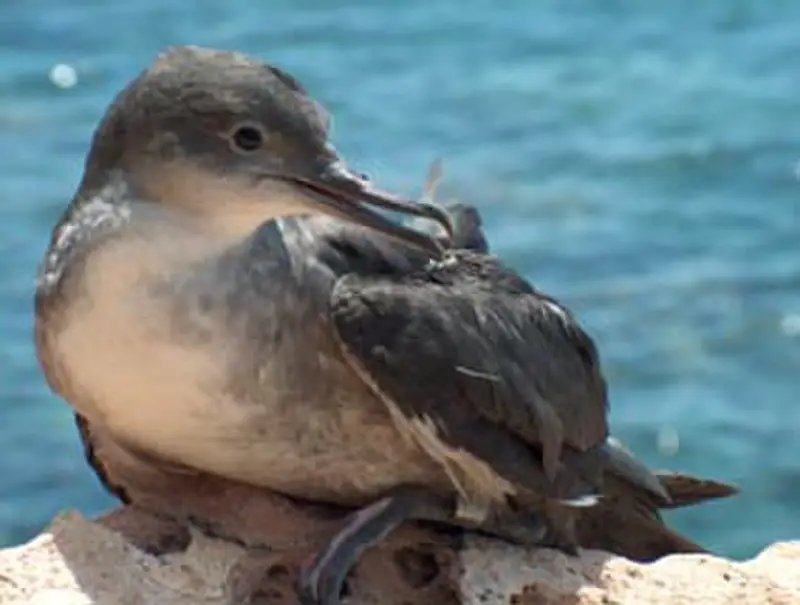
The Balearic shearwater is a medium-sized bird in the Procellariidae family, also known as puffins. It’s named after Mauretania, an old name for North Africa.
These birds can be found around islands and coasts of western Europe and northwest Africa.
They have long wings that help them to fly over vast distances during migration season from their breeding grounds to wintering areas farther south.
Their diet consists mainly of small fish which they catch by diving into the sea with great agility or plucking out of shallow waters while swimming on the surface.
When not mating or raising chicks, these birds live solitary lives at sea but gather together when feeding or roosting on land near coastal cliffsides and beaches where they nest in burrows underground lined with vegetation debris and feathersScientific classification:
| Kingdom | Animalia |
| Phylum | Chordata |
| Class | Aves |
| Order | Procellariiformes |
| Family | Procellariidae |
| Genus | Puffinus |
| Species | P. mauretanicus |
23. Eurasian Blackcap
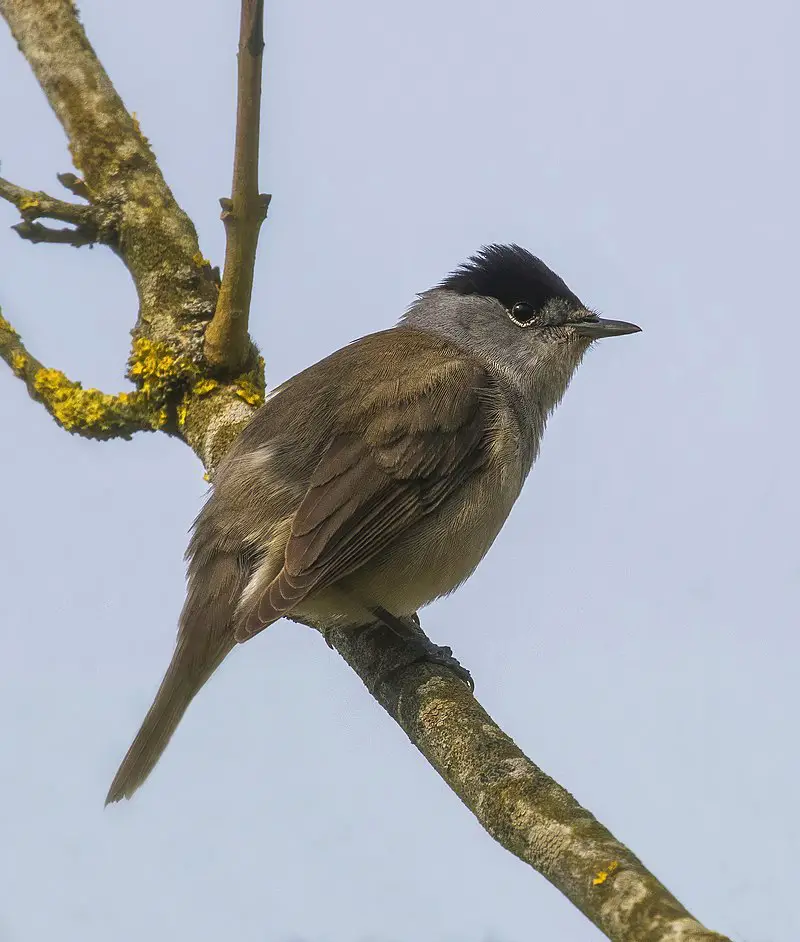
The Eurasian blackcap is a typical warbler, found across Europe and Asia. It has mainly olive-grey upperparts and pale grey underparts. The male has a striking black cap while the female’s is reddish brown in colour.
Males have an attractive song which is usually a rich musical warbling heard during the breeding season.
Blackcaps are small birds with short tails, long wings, stout bills and large feet – perfect for their insectivorous diet of spiders, beetles and other invertebrates they find as they hop along forest floors or among shrubs.
As well as eating insects they also feed on fruits such as elderberries at certain times of year to gain extra energy reserves before migrating southwards to warmer climates over winter months where food sources may be scarce or harder to find.Scientific classification:
| Kingdom | Animalia |
| Phylum | Chordata |
| Class | Aves |
| Order | Passeriformes |
| Family | Sylviidae |
| Genus | Sylvia |
| Species | S. atricapilla |
Also Featured In: Most common Birds in France, Birds that Live in Croatia
24. Little Bustard
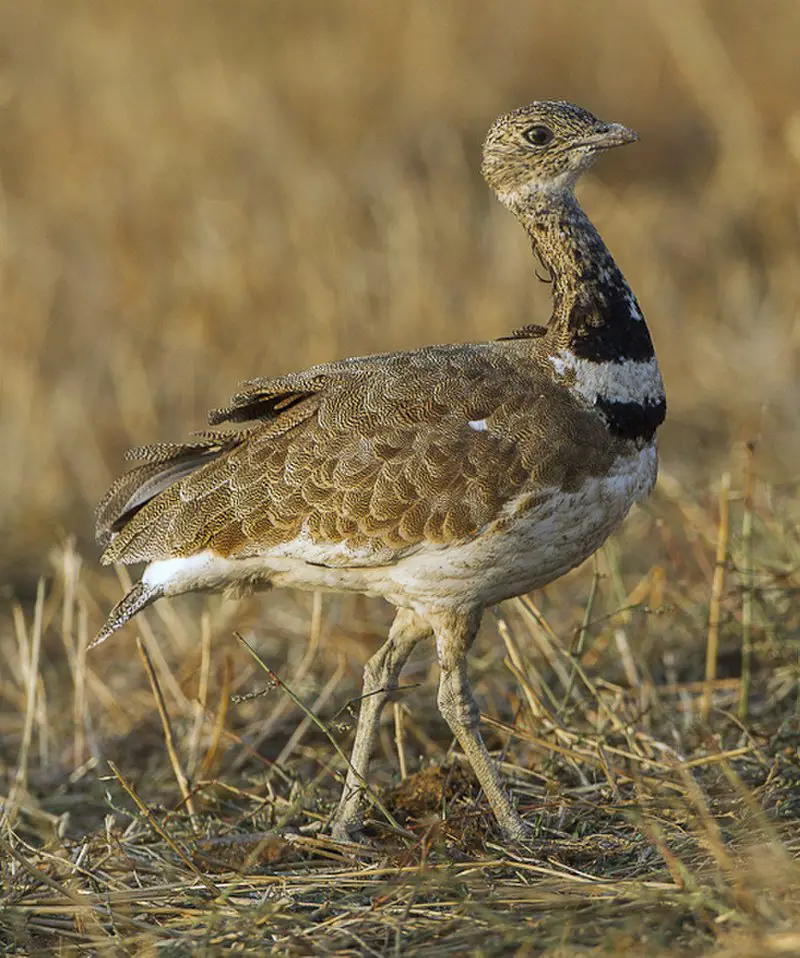
The Little Bustard (Tetrax tetrax) is a bird belonging to the bustard family. It can be found in Southern Europe and Western/Central Asia, with some populations migrating south during wintertime.
This species has an ancient Greek genus name meaning ‘gamebird’, which was mentioned by Aristophanes and other authors of antiquity.
Physically, this bird features mottled feathers that range from greyish-brown on its upperparts to light sandy colors underneath.
Moreover, it also showcases black stripes above each eye as well as dark barring on its wings and tailfeathers.
The little bustard typically feeds off insects while walking or running through open plains but will occasionally nest near cultivated fields too.
All things considered, we should definitely appreciate these birds for their beauty and resilience.Scientific classification:
| Kingdom | Animalia |
| Phylum | Chordata |
| Class | Aves |
| Order | Otidiformes |
| Family | Otididae |
| Genus | Tetrax T. Forster, 1817 |
| Species | T. tetrax |
Also Featured In: Armenian Birds You Should Know,
25. Red-Knobbed Coot
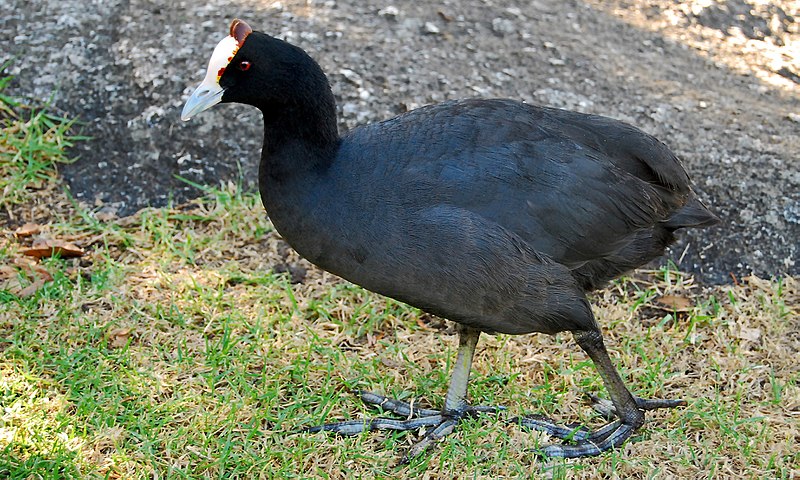
The Red-knobbed Coot is a species of rail and crake bird belonging to the Rallidae family. It is mostly found in Africa with presence in parts of southern Spain, breeding around freshwater lakes and ponds.
They build their nest from dead reeds near water’s edge or on floating platforms, laying about seven eggs but can lay more depending on environmental factors.
It was formally described by Italian ornithologist Giovanni Antonio Scopoli in 1786 as Fulica cristata which translates to “crested coot” due its distinctive red knob located above the bill that it uses for display purposes during courtship rituals.
The Red-knobbed Coot has a black body with white beak and feet, making them quite easy to spot amongst other birds native to similar habitats.Scientific classification:
| Kingdom | Animalia |
| Phylum | Chordata |
| Class | Aves |
| Order | Gruiformes |
| Family | Rallidae |
| Genus | Fulica |
| Species | F. cristata |
Also Featured In: Birds of South African,
26. Great Bustard
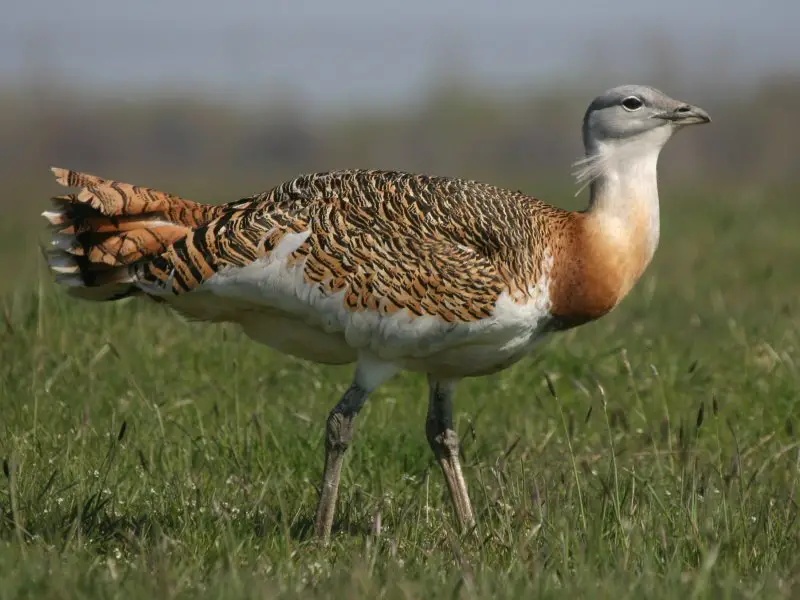
The Great Bustard is a large bird found in open grasslands and farmland across Europe, Central Asia and northern Morocco.
It has a distinctive appearance – its feathers are grey-brown with white below the neck while its head is dark brown.
The species was listed as Vulnerable on the IUCN Red List in 1996 due to population declines caused by habitat loss, overhunting and illegal trade of eggs or chicks.
Conservation efforts provide hope for this majestic creature’s future – some European countries have reintroduced them back into their native habitats through captive breeding programs.
There’s no doubt that we must protect these beautiful birds if they’re to continue soaring majestically above our landscapes for years to come.Scientific classification:
| Kingdom | Animalia |
| Phylum | Chordata |
| Class | Aves |
| Order | Otidiformes |
| Family | Otididae |
| Genus | Otis |
| Species | O. tarda |
Also Featured In: Native South Korean Birds, Birds Found in Hungary
27. Cinereous Vulture
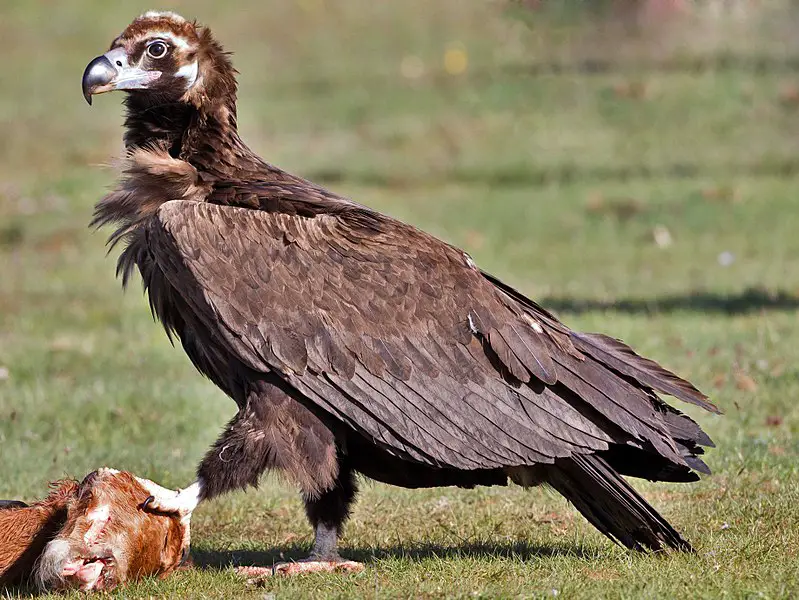
The cinereous vulture, also known as the black vulture, monk vulture and Eurasian black vuture is a large raptor found in temperate Eurasia. It has an impressive wingspan of 3.1 metres (10 feet) with a body length of 1.2 metres (3 ft 11in).
They are the largest Old World Vultures and can reach weights up to 14 kilograms(31 lbs).
Their diet consists mainly of carrion but they have been recorded taking live prey such as rodents or hares which allows them to search for food over wide areas quickly.
These birds usually hunt alone during daylight hours due their eyesight being well adapted at picking out carcasses from far away distances while soaring high in the sky above open grasslands or wooded hillsides where they breed seasonally between late winter and early autumn typically laying one egg per pair each year.Scientific classification:
| Kingdom | Animalia |
| Phylum | Chordata |
| Class | Aves |
| Order | Accipitriformes |
| Family | Accipitridae |
| Genus | Aegypius |
| Species | A. monachus |
Also Featured In: Common Carnivore Birds, Big Birds that Live in Singapore
28. Spanish Imperial Eagle
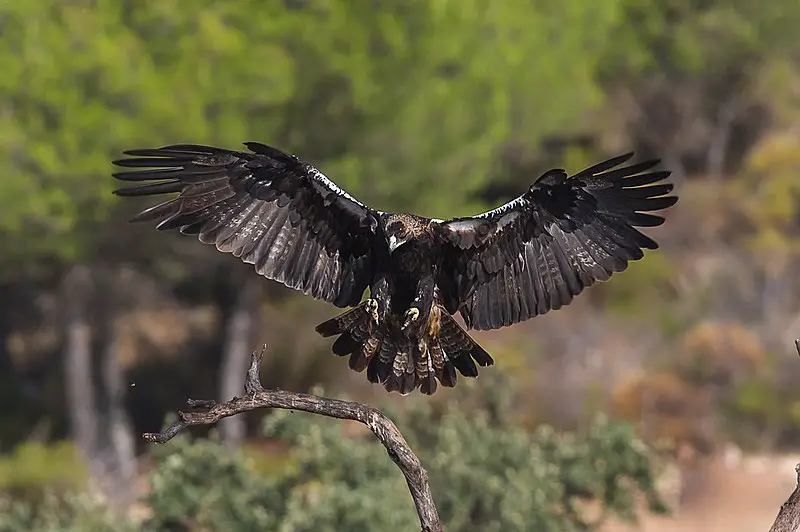
The Spanish imperial eagle is a majestic species of bird native to the Iberian Peninsula. Also known as Adalbert’s Eagle, it was named after Prince Adalbert of Bavaria and can be identified by its distinct white-shouldered “epaulettes”.
This stunning raptor typically features dark brown plumage with light golden feathers on their chest and wings, along with bright yellow eyes and legs.
Measuring up to 75 cm in length with a wingspan of around 1.8 m, these birds are powerful predators equipped for hunting small mammals or carrion found within their forest habitat.
Although formerly considered a subspecies of the Golden eagle due to similarities in size and appearance, research has since proven that this unique species deserves full recognition on its own merits.Scientific classification:
| Kingdom | Animalia |
| Phylum | Chordata |
| Class | Aves |
| Order | Accipitriformes |
| Family | Accipitridae |
| Genus | Aquila |
| Species | A. adalberti |
Also Featured In: Imperial Birds You Should Know,
29. Glossy Ibis
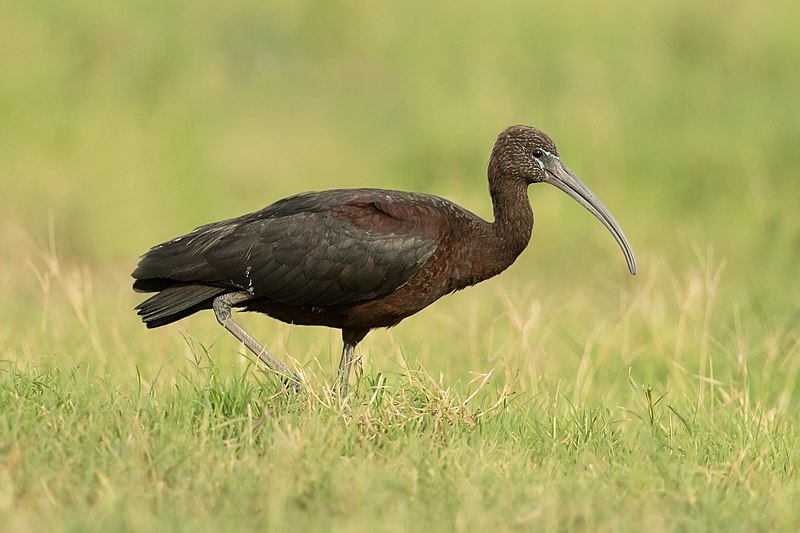
The Glossy Ibis is a water bird that belongs to the family Threskiornithidae. It has an unique bill in the shape of a sickle, which gave it its scientific name – Plegadis falcinellus.
It can be found widely across Europe, Asia and Africa, with scattered nesting sites in warm regions.
Its feathers are black-brown on top and chestnut brown from below; their wings have glossy greenish-purple sheen when seen from afar.
They mainly feed on small insects like grasshoppers, spiders or earthworms as well as crustaceans or amphibians caught while wading through shallow waters.
During breeding season they also consume plant material such as rice grains or corn kernels provided by humans near habitat areas where they nest.Scientific classification:
| Kingdom | Animalia |
| Phylum | Chordata |
| Class | Aves |
| Order | Pelecaniformes |
| Family | Threskiornithidae |
| Genus | Plegadis |
| Species | P. falcinellus |
Also Featured In: Uganda Birds Species, Lebanon Birds Live in Semi-Desert Areas
30. European Bee-Eater
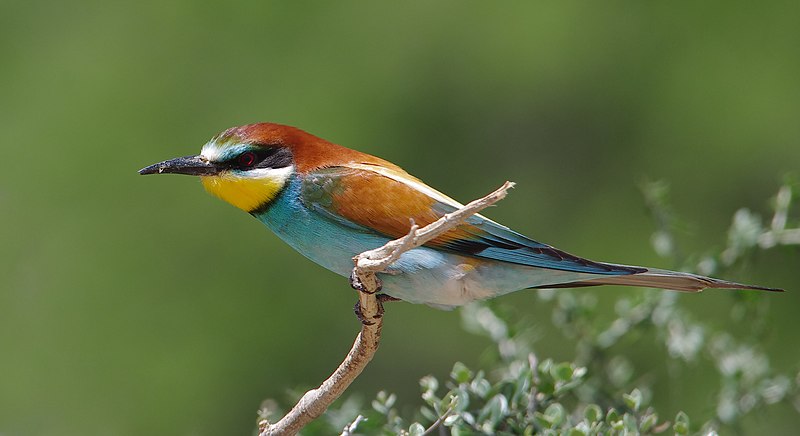
The European Bee-Eater is a stunningly beautiful bird, boasting an array of bright colors. Its head and neck are light blue with greenish ear coverts and its back is chestnut brown.
The wings have yellow primaries bordered in black, while the rest of the feathers contain hues of pink, russet orange, grayish-blue and olive green.
This species can be found breeding throughout Southern Europe to Central Asia as well as Northern Africa to South Africa where it likes to inhabit open country near rivers or streams with bare banks for nesting purposes.
It migrates during winter months down into tropical areas within both Africa and India but will occasionally overshoot northwards which may result in rare sightings elsewhere on occasion too.Scientific classification:
| Kingdom | Animalia |
| Phylum | Chordata |
| Class | Aves |
| Order | Coraciiformes |
| Family | Meropidae |
| Genus | Merops |
| Species | M. apiaster |
Also Featured In: Birds of Poland, African Birds
31. Water Rail
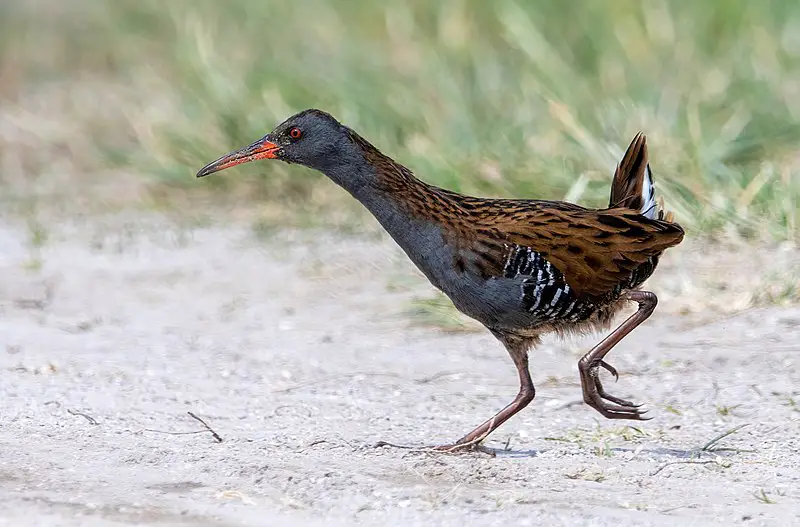
The Water rail is a member of the Rallidae bird family, which inhabits wetlands with dense vegetation. It has a flattened body to aid it in its wetland habitat; this helps it move through long grass and reeds easily.
Adults measure 23-28 cm (9-11 inches) in length and they can be found throughout Europe, Asia and North Africa.
Northern and eastern populations are migratory whereas southern ones remain permanent residents year round.
The bird’s diet consists mainly of insects, small fish, worms, molluscs as well as some plant material like grains or seeds.
Its feathers have an overall brownish grey colouration while its belly is white or creamy yellow with dark markings around the edges of each feather that gives them camouflage against their environment when seen from above or below water level respectively.Scientific classification:
| Kingdom | Animalia |
| Phylum | Chordata |
| Class | Aves |
| Order | Gruiformes |
| Family | Rallidae |
| Genus | Rallus |
| Species | R. aquaticus |
Also Featured In: Common Birds in London, Red European Birds
32. Larks
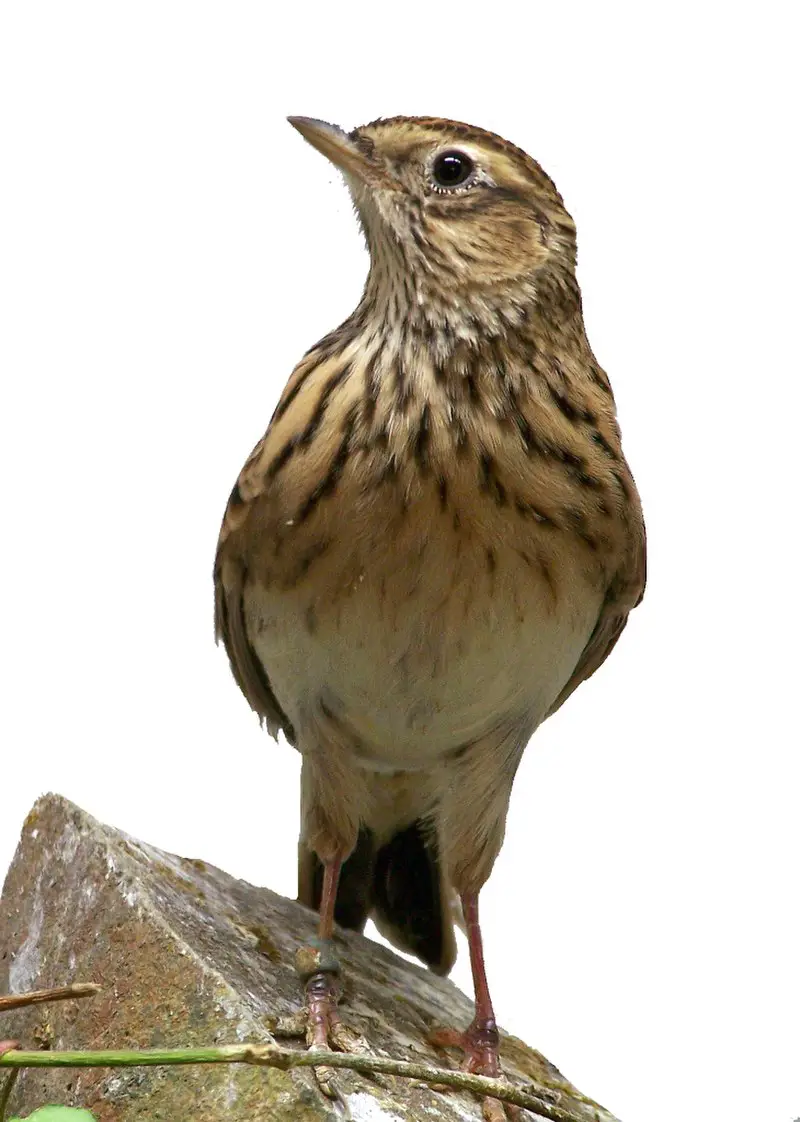
Larks are small passerine birds that belong to the Alaudidae family. These birds have a cosmopolitan distribution and can be found in many different habitats, including dry regions.
The largest number of lark species is located in Africa, while only one species (horned lark) inhabits North America and another one (Horsfield’s bush lark) lives in Australia.
These beautiful creatures usually appear during dawn or dusk as they sing their melodious songs high up into the sky.
Larks possess impressive flying skills which make them capable of reaching heights far above most other bird species.
Despite this skill, they prefer living close to the ground where there are plenty of seeds and insects for them to feed on.Scientific classification:
| Kingdom | Animalia |
| Phylum | Chordata |
| Class | Aves |
| Order | Passeriformes |
| Superfamily | Sylvioidea |
| Family | Alaudidae Vigors, 1825 |
Also Featured In: Birds of Symbolism, Birds that Migrate in United Arab Emirates
33. Marbled Duck
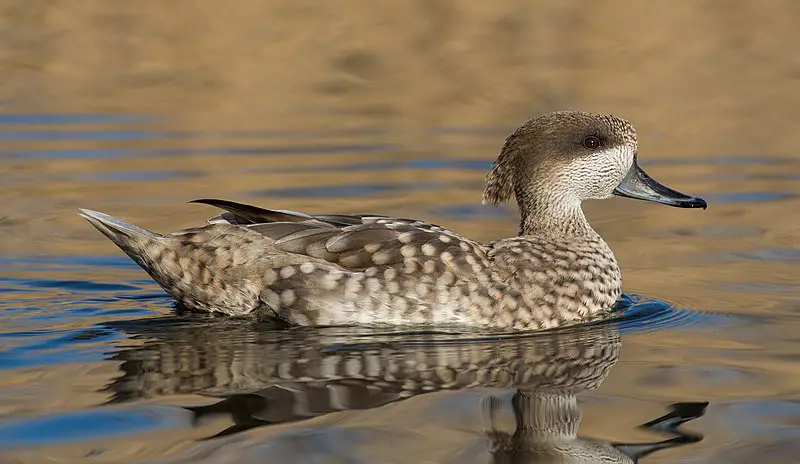
The Marbled duck is a medium-sized species of waterfowl native to southern Europe, northern Africa, and western and central Asia.
It gets its name from the marbling pattern on its feathers which give it an eye-catching mottled appearance.
The scientific name comes from Greek and Latin words meaning “marble”, “duck”, “narrow or small” and ‘billed’ respectively.
In the past these ducks bred in large numbers throughout the Mediterranean region but their population has declined due to human activities such as hunting for sport as well as habitat destruction.
Conservation efforts are underway in order to protect this beautiful bird so that future generations can still enjoy seeing them around.Scientific classification:
| Kingdom | Animalia |
| Phylum | Chordata |
| Class | Aves |
| Order | Anseriformes |
| Family | Anatidae |
| Genus | Marmaronetta Reichenbach, 1853 |
| Species | M. angustirostris |
Also Featured In: Birds of Morocco,
34. Black-Winged Kite
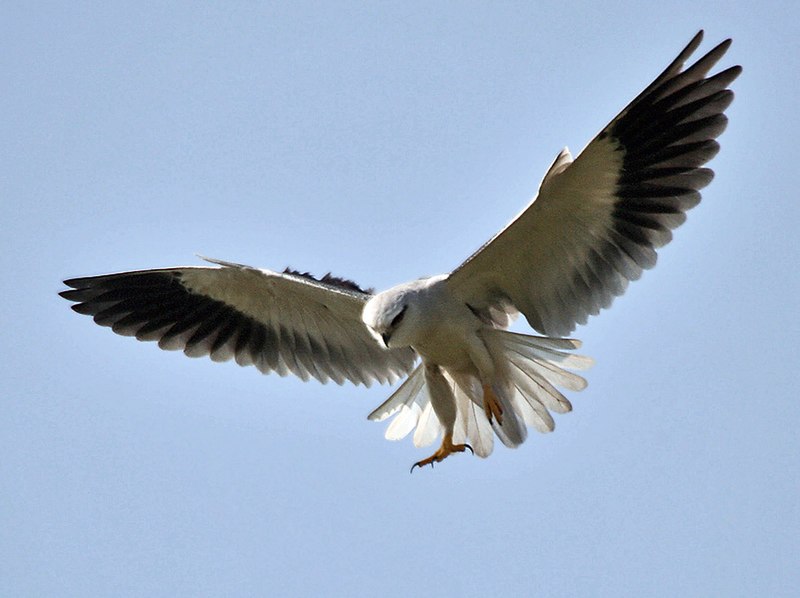
The Black-winged Kite is a small, diurnal bird of prey in the Accipitridae family. It can be found throughout Palearctic and Afrotropical regions.
This species stands out from other birds of prey due to its unique ability to hover over open grasslands like kestrels do.
Its wings are black with white patches on them while its body has gray feathers, giving it a distinct look from the rest of the accipiters.
The underside is mostly white with some barring near the tail area that helps distinguish this species from others.
They feed mainly on insects but will also eat rodents, lizards and even snakes if they come across one.
Because these birds hunt during daylight hours, their diet changes as time passes by – making them quite adaptive hunters.Scientific classification:
| Kingdom | Animalia |
| Phylum | Chordata |
| Class | Aves |
| Order | Accipitriformes |
| Family | Accipitridae |
| Genus | Elanus |
| Species | E. caeruleus |
Also Featured In: Birds Of Côte d’Ivoire, Birds of Goa
35. Lesser Kestrel
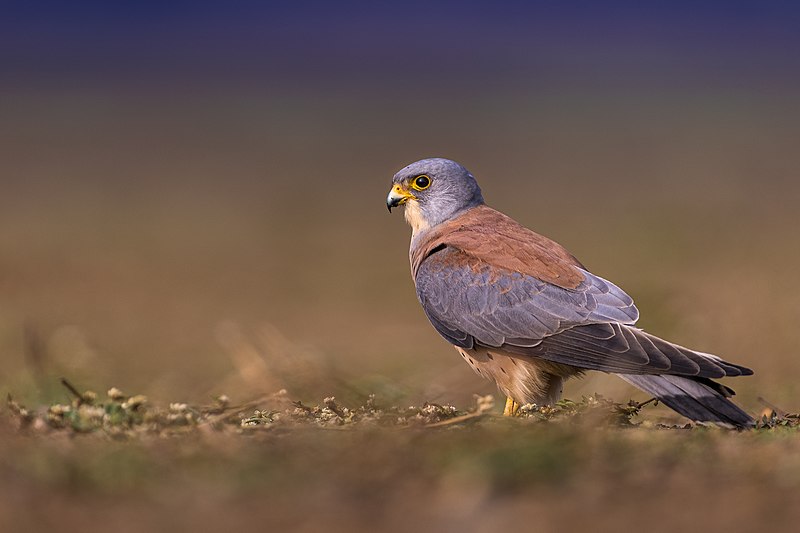
The Lesser Kestrel is a small falcon species that breeds in various regions of the Mediterranean, Afghanistan, Central Asia, China and Mongolia. During summer they migrate to Africa, Pakistan and even India or Iraq.
The population of this bird has been declining in its European range but it remains rare north of its breeding locations.
Its genus name “Falco” derives from Late Latin meaning sickle which describes their curved beak shape used for hunting prey like insects or lizards.
Their diet also consists mainly on seeds and grains as well as some fruits when available making them versatile hunters able to survive different climates where food may vary seasonally.Scientific classification:
| Kingdom | Animalia |
| Phylum | Chordata |
| Class | Aves |
| Order | Falconiformes |
| Family | Falconidae |
| Genus | Falco |
| Species | F. naumanni |
Also Featured In: Most Beautiful birds of Greece,
36. Crested Lark
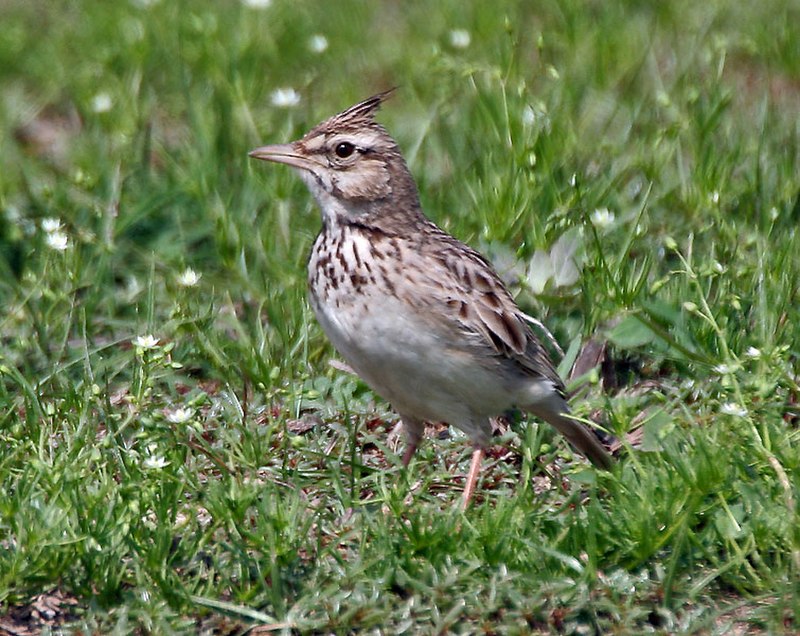
The Crested Lark is a species of lark that can be found across Eurasia and northern Africa. This non-migratory bird rarely appears as a vagrant in Great Britain.
It was originally described by Carl Linnaeus in 1758 for his 10th edition of Systema Naturae, under the genus Alauda until German naturalist Friedr Merrem moved it to its own genus Galerida in 1804.
The Crested Lark has an overall sandy color with darker brown wings and back, white underside, dark tail feathers and blackish bill.
Its most distinguishing feature are the two tufts on either side of its head which gives this species its name.Scientific classification:
| Kingdom | Animalia |
| Phylum | Chordata |
| Class | Aves |
| Order | Passeriformes |
| Family | Alaudidae |
| Genus | Galerida |
| Species | G. cristata |
Also Featured In: Common Birds of the Jordan, Common Birds of Lesbos Island
37. Eurasian Griffon Vulture
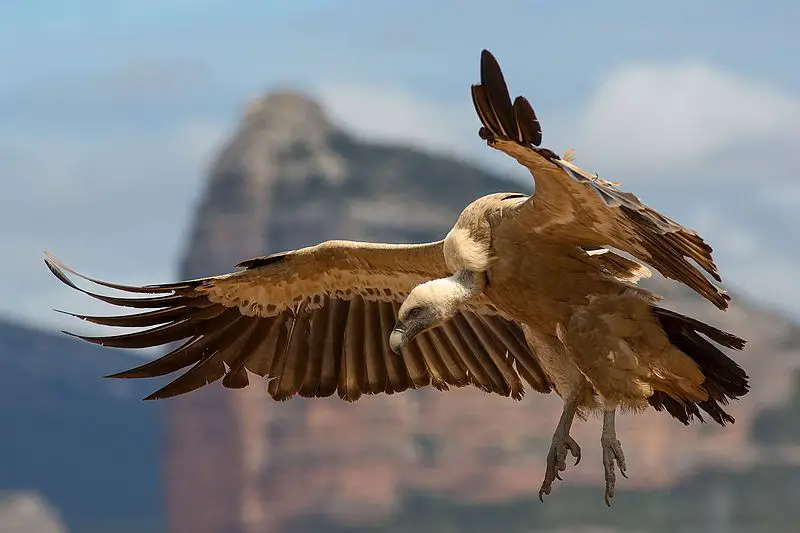
The Eurasian griffon vulture (Gyps fulvus) is an impressive Old World bird of prey. It has a wingspan that can reach up to 4.8 meters and is usually between 93-122 cm in length.
Its body feathers are dark brown with lighter areas on its head, chest and wings while the underside of its tail and flight feathers are white.
This species feeds primarily on carrion but will also scavenge for food when necessary; they have been known to form large groups in order to increase their chances of finding a meal or being able to steal one from another group member.
The Griffon Vulture’s natural habitat ranges across Europe, Asia Minor, North Africa into parts of India as well as some islands off the coast such as Crete and Cyprus.
They nest fairly high up either alone or in small colonies – often using old nests built by other birds like eagles or storks to save time.Scientific classification:
| Kingdom | Animalia |
| Phylum | Chordata |
| Class | Aves |
| Order | Accipitriformes |
| Family | Accipitridae |
| Genus | Gyps |
| Species | G. fulvus |
Also Featured In: Birds found in portugal, Most Common Birds of Sardinia
38. Booted Eagle
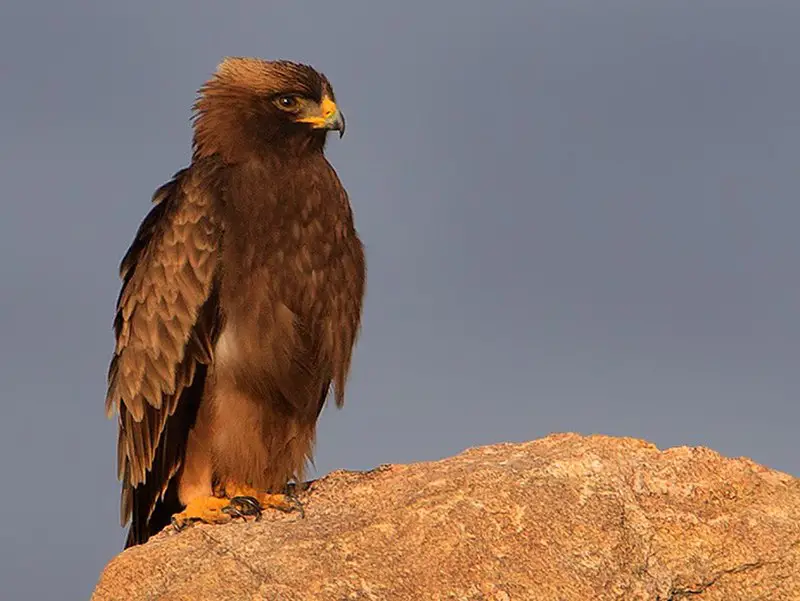
The Booted Eagle is a medium-sized bird of prey, typically found in the Palearctic and southern Asia. During winter months they migrate to Africa and Asia’s tropical regions.
A small population also breeds in south western Africa. It belongs to the Accipitridae family which includes all eagles.
Described formally back in 1780, it has an impressive wingspan reaching up to 1 meter across.
With its black tail feathers contrasting against its brown body plumage with white patches on the underside of their wings when seen from below makes for easy identification amongst other birds of prey during flight or perched atop trees or buildings surveying for potential food sources like rodents, insects and even reptiles at times.Scientific classification:
| Kingdom | Animalia |
| Phylum | Chordata |
| Class | Aves |
| Order | Accipitriformes |
| Family | Accipitridae |
| Genus | Hieraaetus |
| Species | H. pennatus |
Also Featured In: Big Birds that Live in Uganda, Large Birds of Uganda
39. Short-Toed Snake Eagle
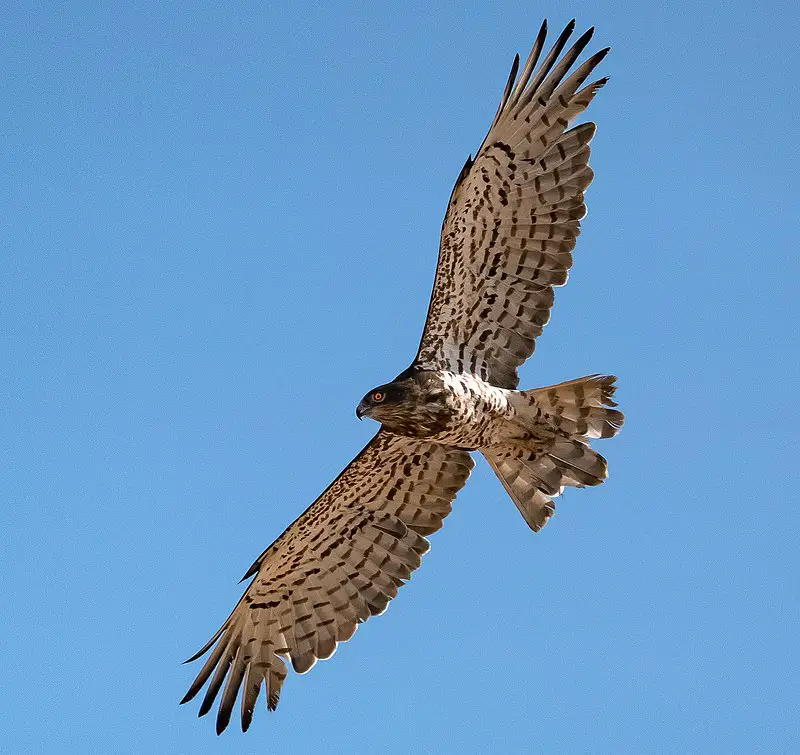
The Short-toed Snake Eagle is a medium sized bird of prey that belongs to the Accipitridae family. It has a wide distribution across Europe, Asia and Africa.
The species name ‘gallicus’ refers to Gallia, which was an ancient region in Western Europe corresponding mostly to what is now France.
This raptor feeds mainly on snakes but also preys upon lizards and small mammals like rodents and bats.
Its diet allows it to thrive even in areas with limited food resources as its main source of nourishment are easily found reptiles.
The short-toed eagle prefers open habitats such as grasslands or steppes where they can hunt more efficiently using their sharp vision combined with agile flight manoeuvres which allow them to quickly snatch up their prey from long distances away.Scientific classification:
| Kingdom | Animalia |
| Phylum | Chordata |
| Class | Aves |
| Order | Accipitriformes |
| Family | Accipitridae |
| Genus | Circaetus |
| Species | C. gallicus |
40. Bearded Vulture
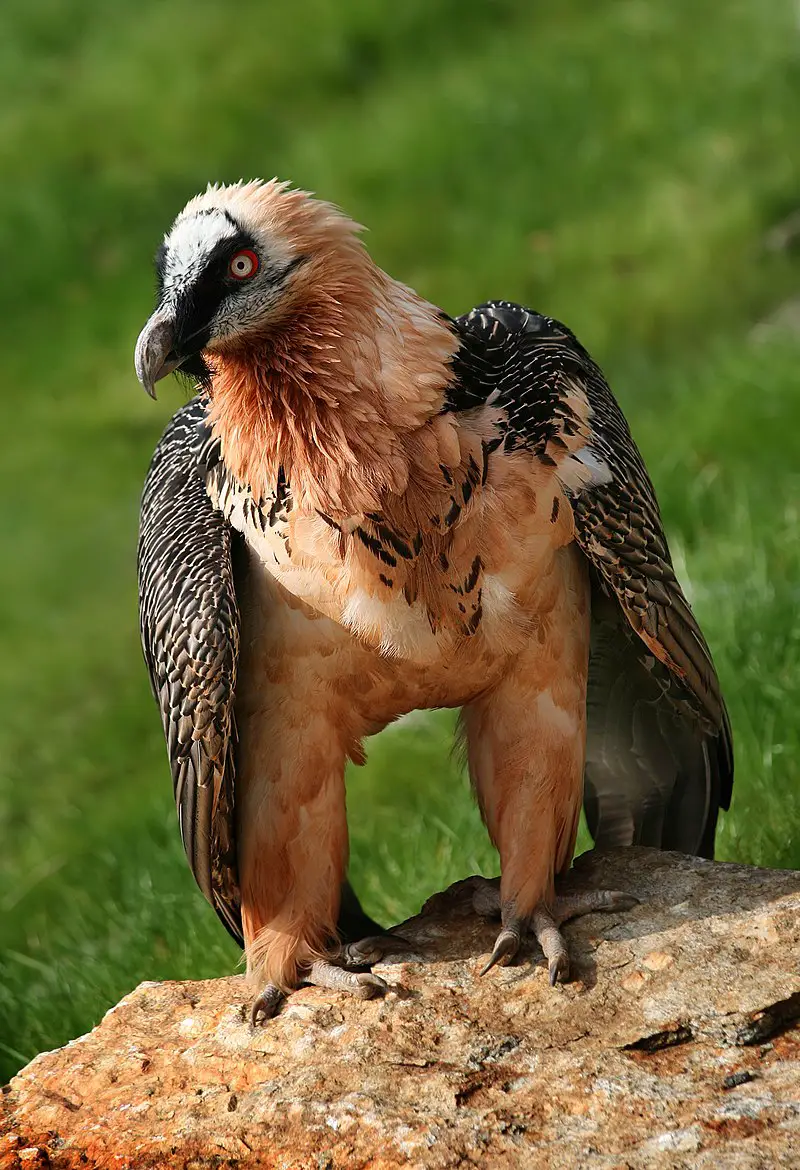
The Bearded vulture, also known as the lammergeier and ossifrage, is a majestic bird of prey belonging to its own genus within Accipitridae. It has an impressive wingspan that can reach up to 2.5m wide.
Its habitat ranges from Europe through Africa and into parts of Asia, where it prefers rocky areas with cliffs or mountainsides for nesting sites.
The bearded vulture’s diet consists mainly of carrion but it will occasionally feed on small mammals such as rabbits or hares too – using their powerful beak to crack open bones in order to get at the nutritious marrow inside.
These birds are highly endangered due primarily to human interference so conservation efforts must continue in order for us all have them around for future generations.Scientific classification:
| Kingdom | Animalia |
| Phylum | Chordata |
| Class | Aves |
| Order | Accipitriformes |
| Family | Accipitridae |
| Genus | Gypaetus Storr, 1784 |
| Species | G. barbatus |
Also Featured In: Common Birds Found in Switzerland, Birds that Live in the Deserts
41. Pin-Tailed Sandgrouse
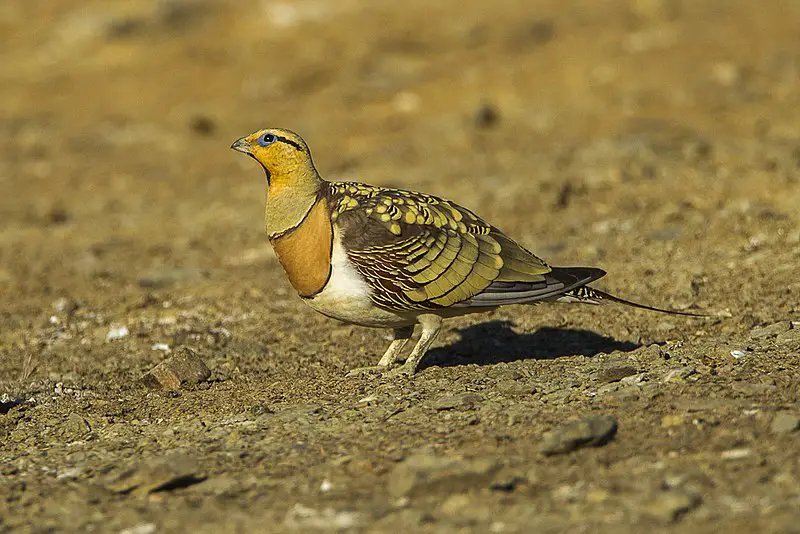
The Pin-tailed Sandgrouse is a medium-sized bird with a small, pigeon-like head and neck and sturdy body. It has long pointed wings that are white underneath, as well as a long tail and fast direct flight.
They congregate in flocks to watering holes at dawn, making loud calls of “kattar-kattar”. This social species lives on open treeless plains or similar areas where they can find food such as seeds or insects.
During breeding season the male will perform an impressive display which involves fanning out its tail feathers while displaying his bright yellow eye patch to attract females.
The male also provides water for the female by sopping up moisture from damp ground in its breast feathers before flying back to meet her at their nest site where she incubates their eggs until hatching occurs.
These birds have adapted over time to survive some harsh climates but now face threats due to habitat destruction and hunting pressure; conservation efforts must be put into place if we are going keep this incredible species alive for future generations.Scientific classification:
| Kingdom | Animalia |
| Phylum | Chordata |
| Class | Aves |
| Order | Pterocliformes |
| Family | Pteroclidae |
| Genus | Pterocles |
| Species | P. alchata |
Also Featured In: Kuwait Birds, Birds That Live in Iraq
42. Squacco Heron
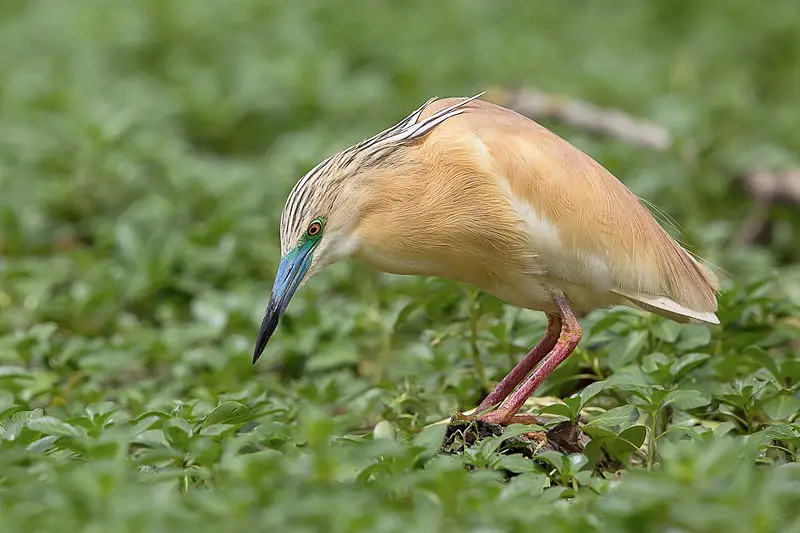
The Squacco Heron is a small heron species native to the Old World that breeds in parts of Europe and the Greater Middle East, before migrating south for winter.
They measure around 44-47 cm long with an 80-92 cm wingspan, making them one of the smaller species of herons.
Their body length measures 20-23cm while they have greyish or brown plumage on top and white or yellow underneath.
The neck has some streaking patterns giving it its name “squacco” which means speckled in Italian. It feeds mainly on fish, frogs and insects near shallow waters such as marshes, swamps and streams.
Rarely sighted north of their breeding grounds this curious little bird should be admired if spotted.Scientific classification:
| Kingdom | Animalia |
| Phylum | Chordata |
| Class | Aves |
| Order | Pelecaniformes |
| Family | Ardeidae |
| Genus | Ardeola |
| Species | A. ralloides |
Also Featured In: Bahrain birds, Common Birds in Tuscany
43. Western Marsh Harrier
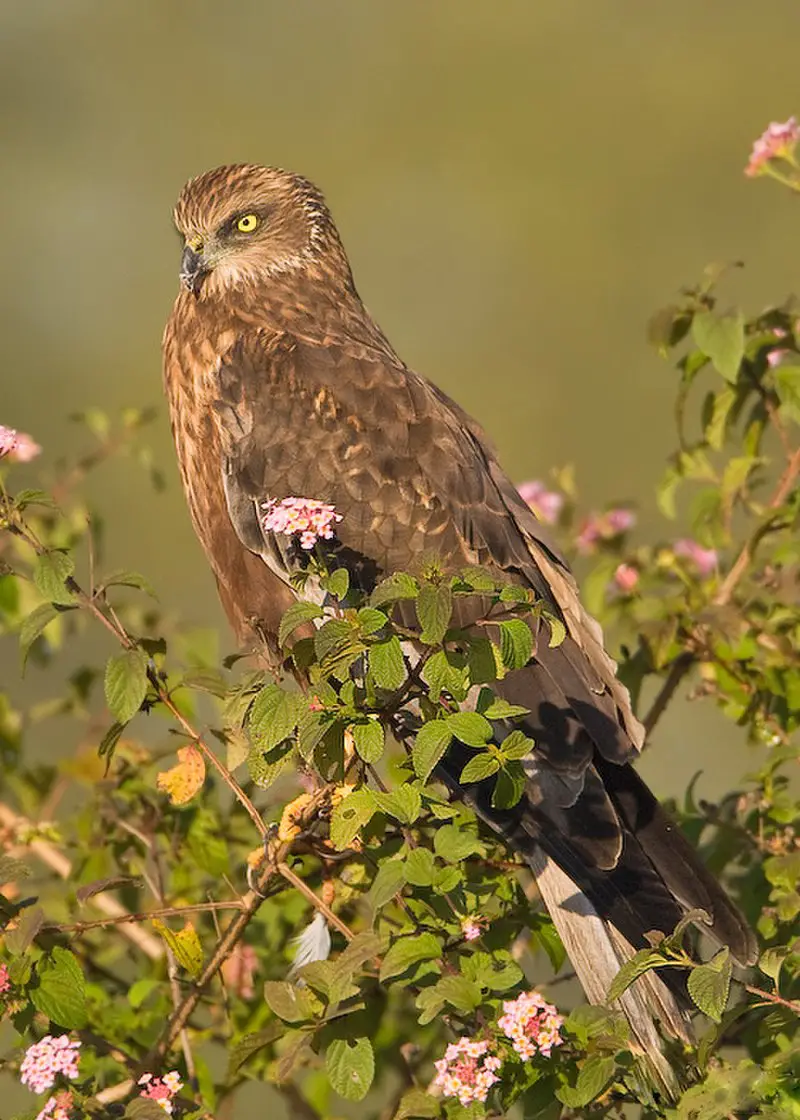
The Western marsh harrier is a large bird of prey that is found throughout temperate and subtropical regions in western Eurasia and Africa.
It has greyish brown plumage with white patches on the underside, yellow eyes, long legs and wingspan reaching up to 1 meter.
This species mainly feeds on small mammals such as rodents and voles which it catches by swooping down from above while flying over marshes or wetlands.
Nesting usually occurs in tall trees near water bodies where they build their nests made out of sticks lined with grasses or feathers.
The female lays 3-5 eggs during breeding season which hatch after an incubation period of 31 days.
They are known for making loud calls when defending its territory against other birds like buzzards and eaglesScientific classification:
| Kingdom | Animalia |
| Phylum | Chordata |
| Class | Aves |
| Order | Accipitriformes |
| Family | Accipitridae |
| Genus | Circus |
| Species | C. aeruginosus |
Also Featured In: Malta birds, Birds of Norfolk
44. Sandpiper
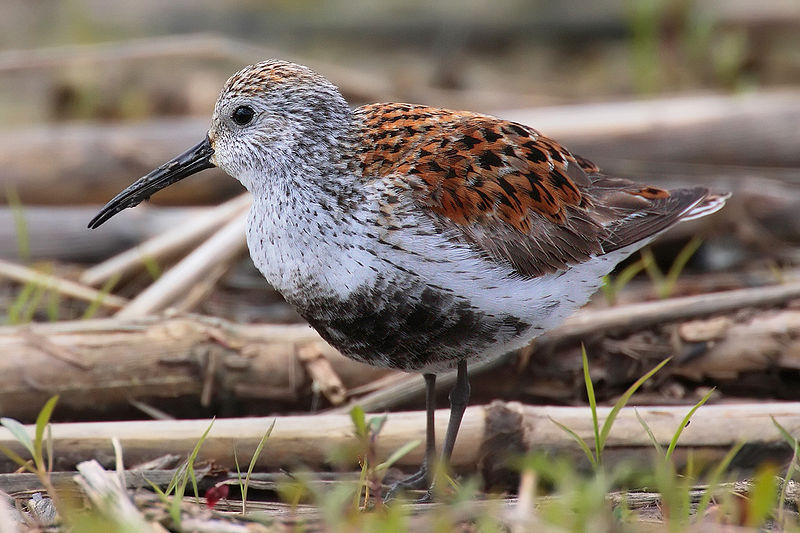
Sandpiper is a type of wading bird that belongs to the family Scolopacidae. It is a diverse family that includes various species such as curlew and snipe.
Sandpipers have different bill lengths that allow them to feed on small invertebrates and creatures found in mud or soil.
Due to this diversity, different species can coexist in the same habitat without competing for food.
Sandpipers are commonly found near the coast but are also found in other wetland environments.
They are known for their slender legs, long beak, and streamlined body that enables them to move easily in and out of water.
Sandpipers are a unique and fascinating bird species that are interesting to observe in their natural habitat.Scientific classification:
| Kingdom | Animalia |
| Phylum | Chordata |
| Class | Aves |
| Order | Charadriiformes |
| Suborder | Scolopaci |
| Family | Scolopacidae Rafinesque, 1815 |
Also Featured In: Birds You’ll Find in the Sea, Turkey Birds You Should Know
45. European Robin
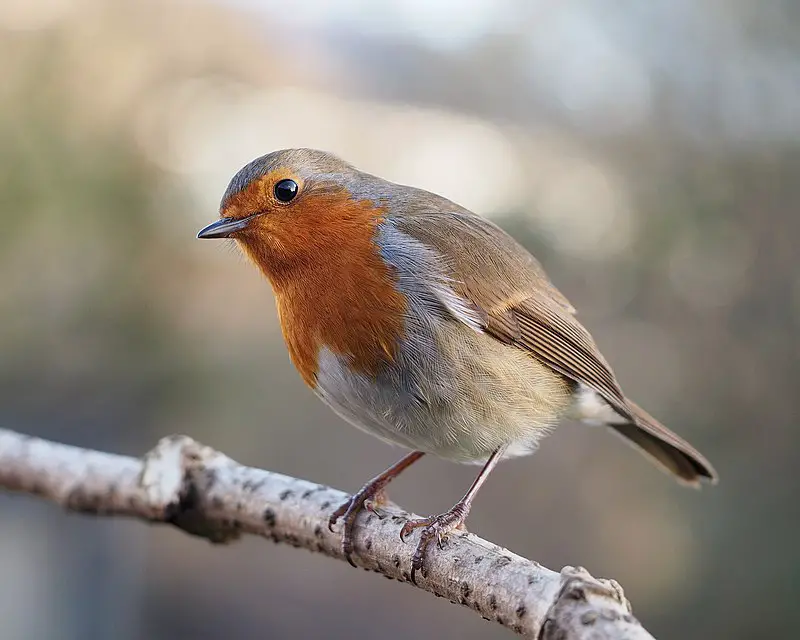
The European robin, also known as simply robin or robin redbreast, is a small insect-eating bird belonging to the chat subfamily.
This bird species can be found across Europe, extending east to Western Siberia while inhabiting North Africa.
The bird species is relatively sedentary and is found in most of its range, except for the far north.
Measuring around 12.5-14.0 cm, this bird is commonly known for its distinctively red breast feathers.
As an insectivorous passerine bird, the European robin mainly feeds on insects to sustain its energy.
Given its widespread range throughout Europe and continuous presence in certain parts of the world, the European robin is widely recognized for its distinct physical appearance, singsong voice, and tiny size.Scientific classification:
| Kingdom | Animalia |
| Phylum | Chordata |
| Class | Aves |
| Order | Passeriformes |
| Family | Muscicapidae |
| Genus | Erithacus |
| Species | E. rubecula |
Also Featured In: Most Common Songs Birds that Live around You, Italian Birds You Should Know
46. Spotless Starling
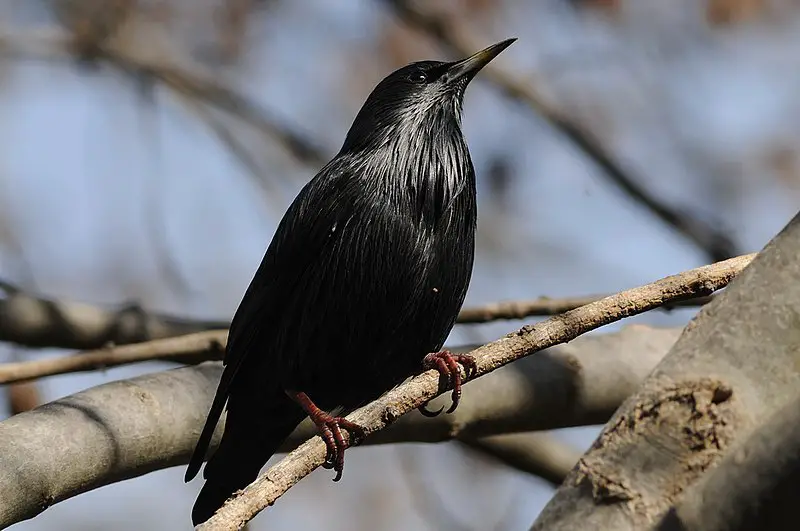
The spotless starling is a type of passerine bird that belongs to the Sturnidae family. It is closely related to the common starling, but its range is much more limited.
These birds are native to the Iberian Peninsula, Northwest Africa, southernmost France, and certain islands. They are known for their non-migratory habits.
Despite their small range, spotless starlings are common in their native regions, and they are often seen in urban areas, parks, and gardens.
These birds are easily identifiable by their glossy black feathers and bright yellow beaks. They are omnivores and feed on a range of foods, including insects, fruit, and seeds.
The spotless starling is a unique and interesting bird species that is well adapted to its local environment.Scientific classification:
| Kingdom | Animalia |
| Phylum | Chordata |
| Class | Aves |
| Order | Passeriformes |
| Family | Sturnidae |
| Genus | Sturnus |
| Species | S. unicolor |
47. Eurasian Magpie
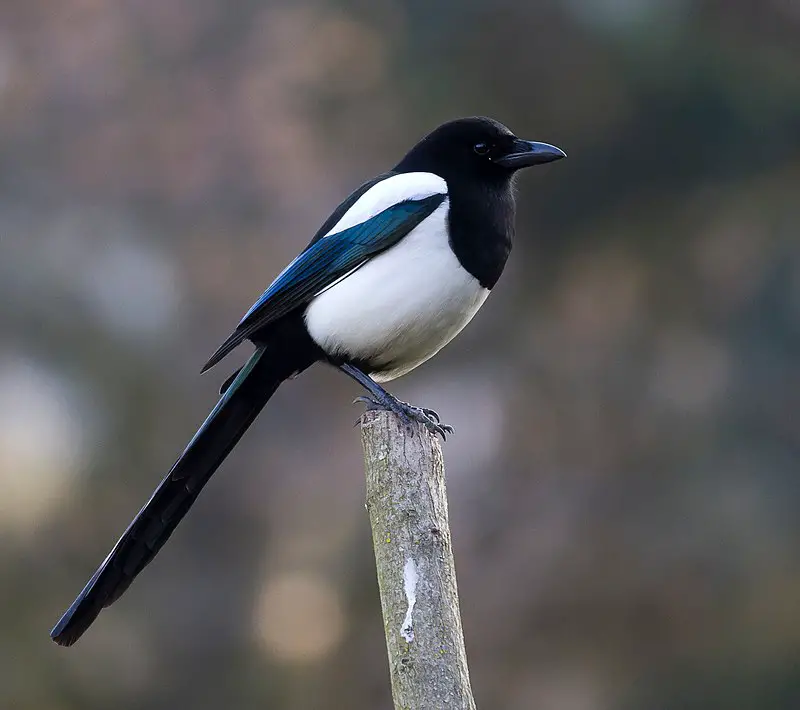
The Eurasian magpie, also known as the common magpie, is a bird found in the northern part of the Eurasian continent. It belongs to the corvids family and is part of the “monochrome” magpies.
The bird is a resident breeder that is always available in Europe. The only other magpie found in Europe is the Iberian magpie.
The magpie is often used as a synonym for the Eurasian magpie by English speakers.
The bird has a distinct black and white appearance and is known for its intelligent behavior. It can imitate sounds heard in its environment and also demonstrates self-awareness.
The Eurasian magpie is omnivorous and feeds on insects, small mammals, and fruits.
It forms monogamous pairs that last for a lifetime and builds nests in trees or bushes. The bird is not endangered and is often regarded as a nuisance due to its habit of raiding gardens for food.Scientific classification:
| Kingdom | Animalia |
| Phylum | Chordata |
| Class | Aves |
| Order | Passeriformes |
| Family | Corvidae |
| Genus | Pica |
| Species | P. pica |
Also Featured In: Ukrainian Birds You Should Know, Common Estonian Birds
48. Thekla’s Lark
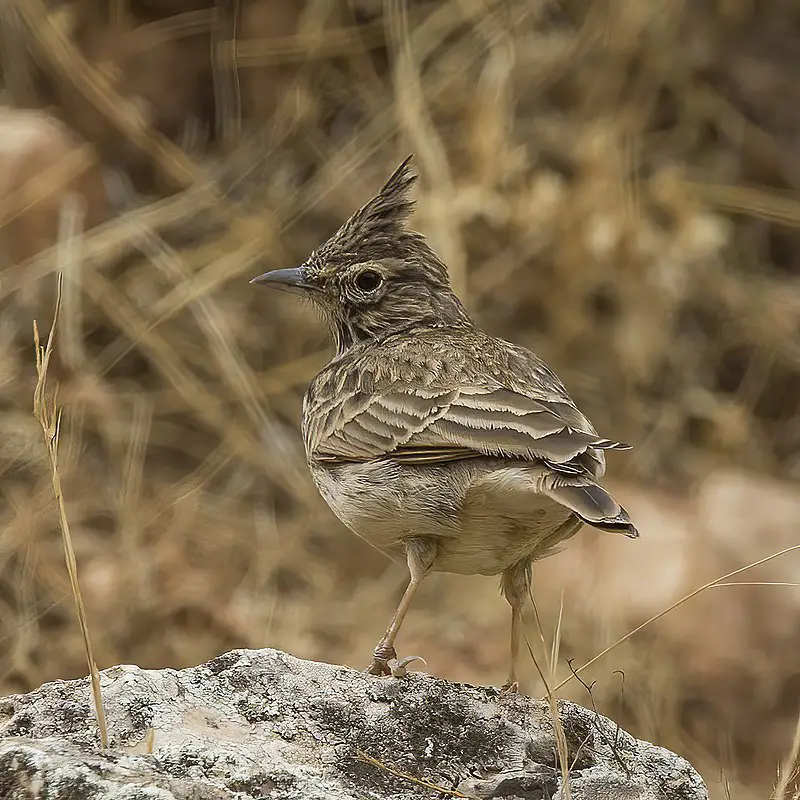
The Thekla’s lark, also known as the Thekla lark, is a non-migratory bird species found in various parts of Africa and the Iberian Peninsula. This bird is commonly found in dry open areas and at higher elevations.
It was named after Thekla Brehm by Alfred Edmund Brehm in 1857.Scientific classification:
| Kingdom | Animalia |
| Phylum | Chordata |
| Class | Aves |
| Order | Passeriformes |
| Family | Alaudidae |
| Genus | Galerida |
| Species | G. theklae |
Also Featured In: Birds Live in Tunisia, Most Popular Birds in Mallorca
49. Zitting Cisticola
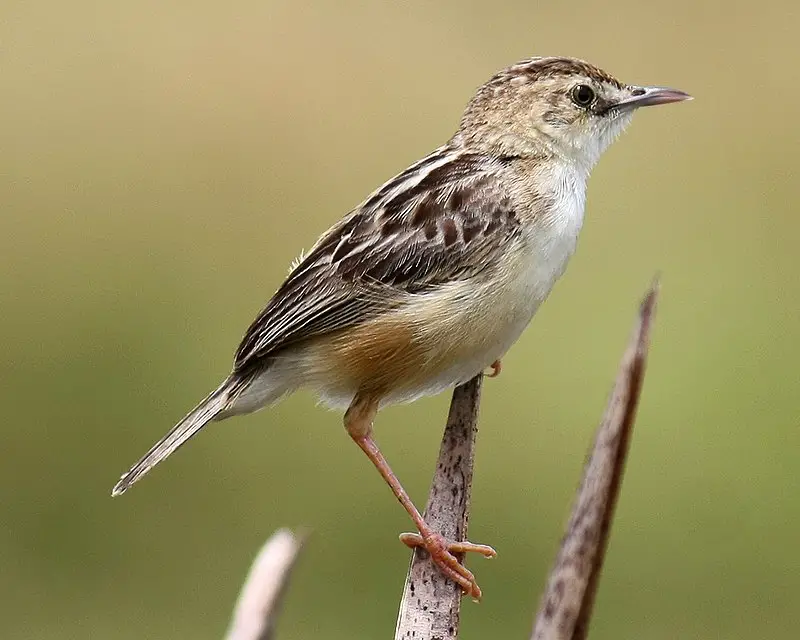
The Zitting cisticola, also known as the streaked fantail warbler, is a small bird found in grasslands across southern Europe, Africa (excluding deserts and rainforests), and southern Asia, down to northern Australia.
It has a distinctive rufous rump and lacks any gold on the collar. Its tail is brownish in color. This Old World warbler is commonly found in open areas with tall grass and feeds on insects.
The Zitting cisticola makes a distinctive sound, described as a “zit-zit-zit,” hence its name.
It is known for performing wonderful displays during breeding season, which involves singing while flying steeply upwards before plummeting downwards with an outspread tail.
Despite being widely distributed, the species is currently considered of “Least Concern” by the International Union for Conservation of Nature (IUCN).Scientific classification:
| Kingdom | Animalia |
| Phylum | Chordata |
| Class | Aves |
| Order | Passeriformes |
| Family | Cisticolidae |
| Genus | Cisticola |
| Species | C. juncidis |
Also Featured In: Birds that Charles Darwin Studied, Coastal Birds That Live around Miyako-jima
50. Iberian Grey Shrike
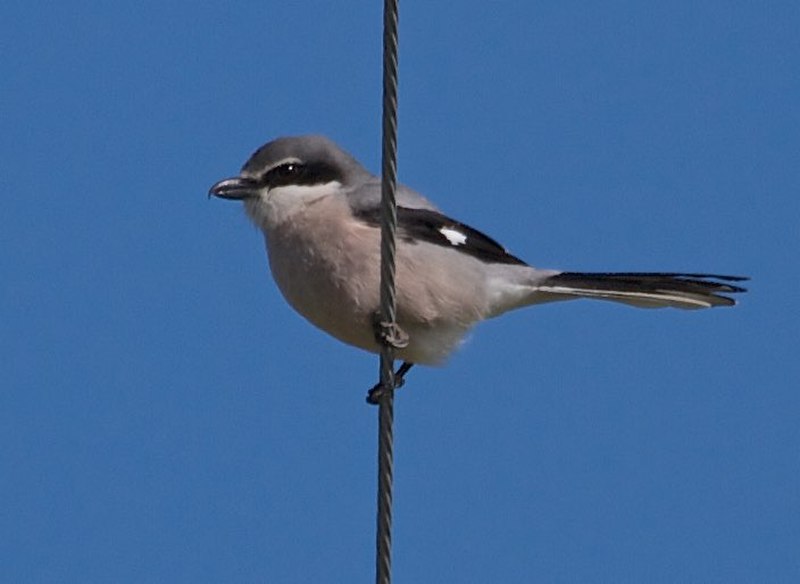
The Iberian grey shrike is a bird belonging to the shrike family. It appears quite similar to the great grey shrike species except for a few distinctive features.
It was once thought to be the same species as the latter but was later identified as a distinct one. Interestingly, these two species do not breed with each other and are separated by their different habitats.
The Iberian grey shrike is typically found in the Iberian Peninsula and certain parts of North Africa. Its diet primarily consists of insects and small vertebrates.
It is also known for its unique hunting behavior where it impales its prey on sharp objects such as thorns before consuming them later.
Overall, the Iberian grey shrike is a fascinating bird that has adapted to its environment and gained its place in the diverse family of shrikes.Scientific classification:
| Kingdom | Animalia |
| Phylum | Chordata |
| Class | Aves |
| Order | Passeriformes |
| Family | Laniidae |
| Genus | Lanius |
| Species | L. meridionalis |
Also Featured In: Birds of Lanzarote, Fuerteventura Island Birds You Need to See
51. White-Headed Duck
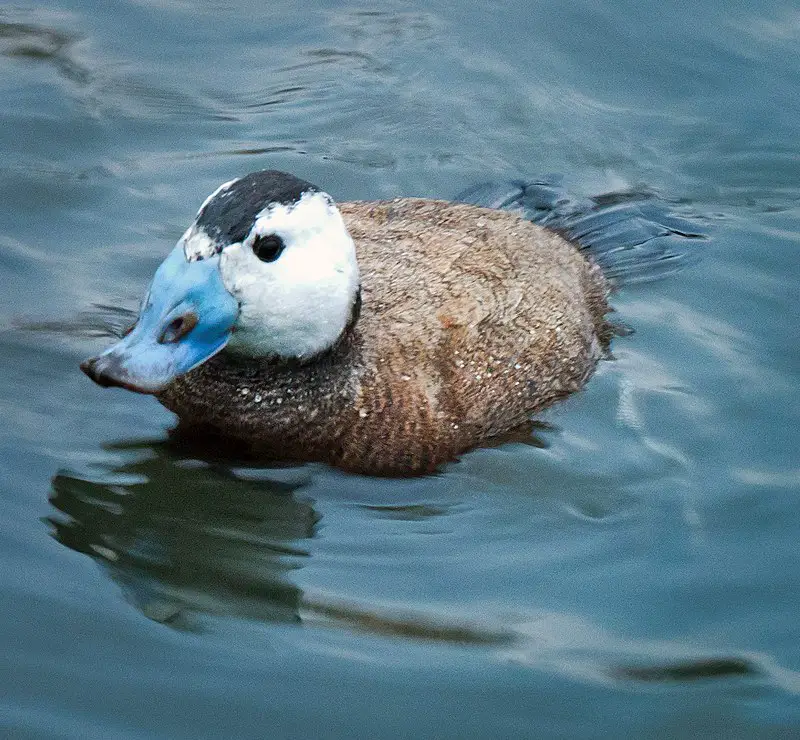
The white-headed duck, also known as Oxyura leucocephala, is a relatively small diving bird measuring at about 45 cm in length.
The males have unique features which include a black crown, blue bill and reddish-grey feathers, while females have a dark bill and a more somber coloring.
They can be found in lakes that contain open water and dense vegetation near the margins, where they use their specialized diving skills to feed on aquatic vegetation and some animal matter.
Due to habitat loss and reduction in population, the white-headed duck has been classified as a vulnerable species by the International Union for Conservation of Nature (IUCN).
It is crucial to protect their natural habitats through reforestation and limiting human activity to avoid the possible extinction of this species.Scientific classification:
| Kingdom | Animalia |
| Phylum | Chordata |
| Class | Aves |
| Order | Anseriformes |
| Family | Anatidae |
| Genus | Oxyura |
| Species | O. leucocephala |